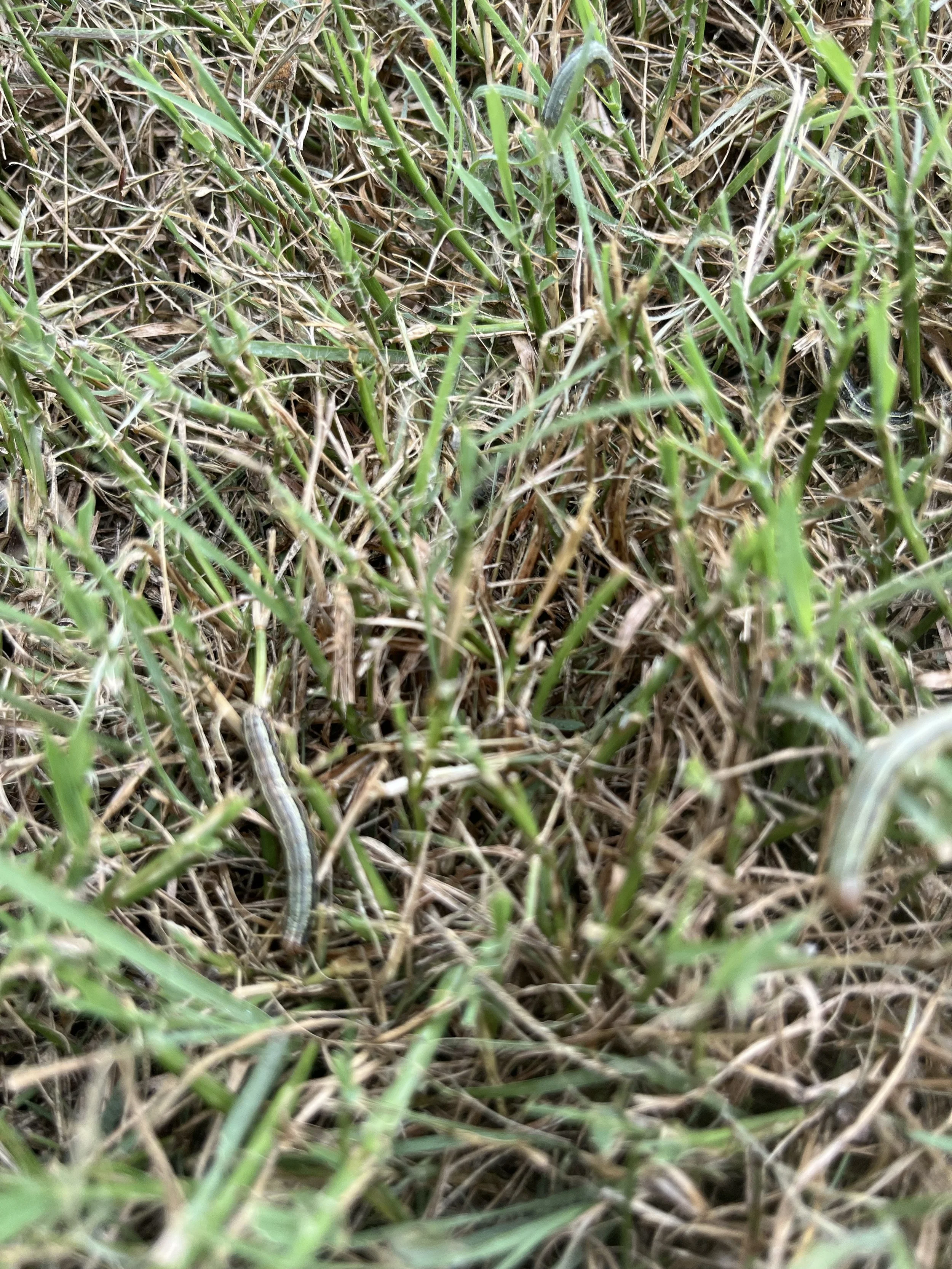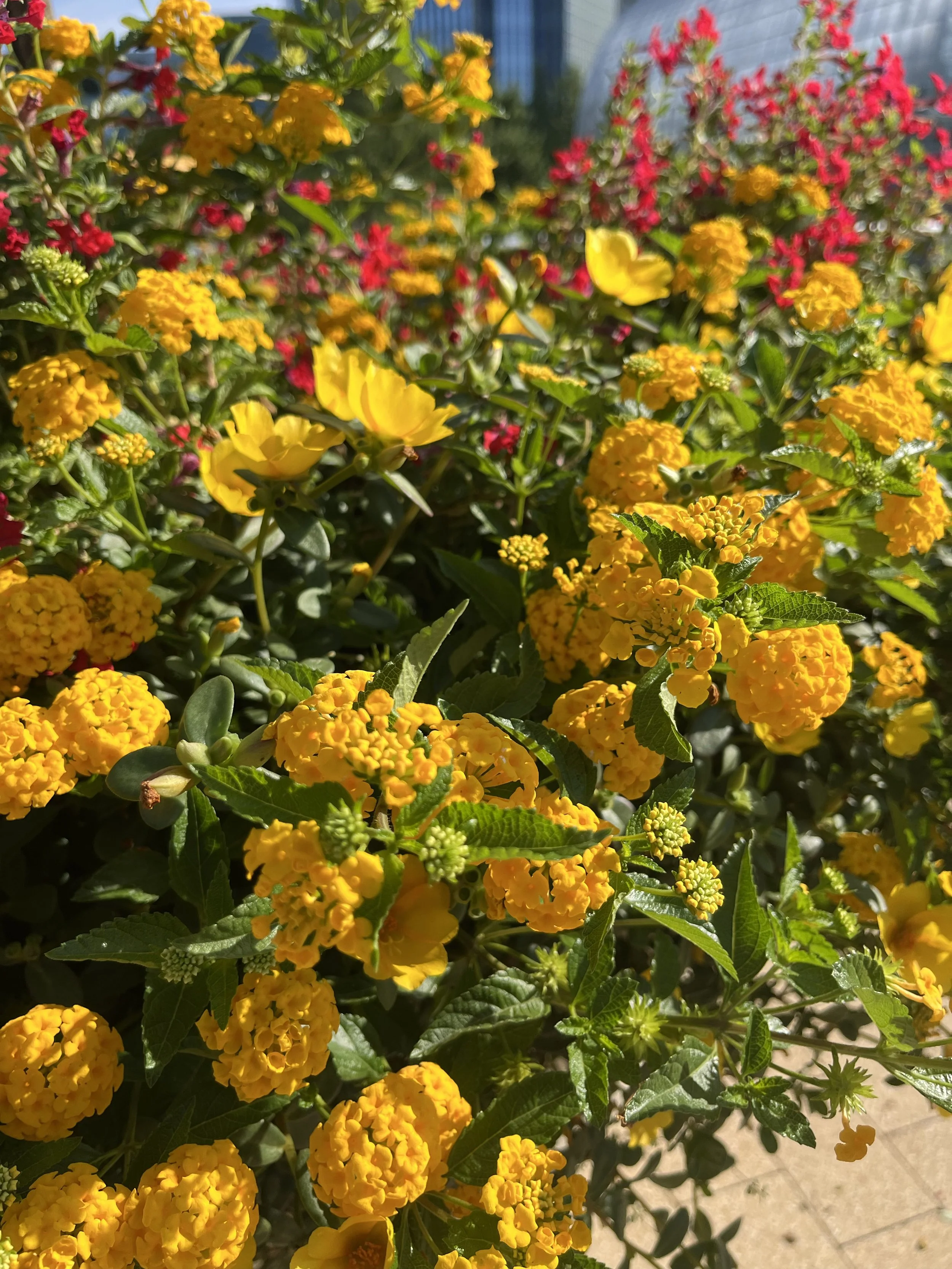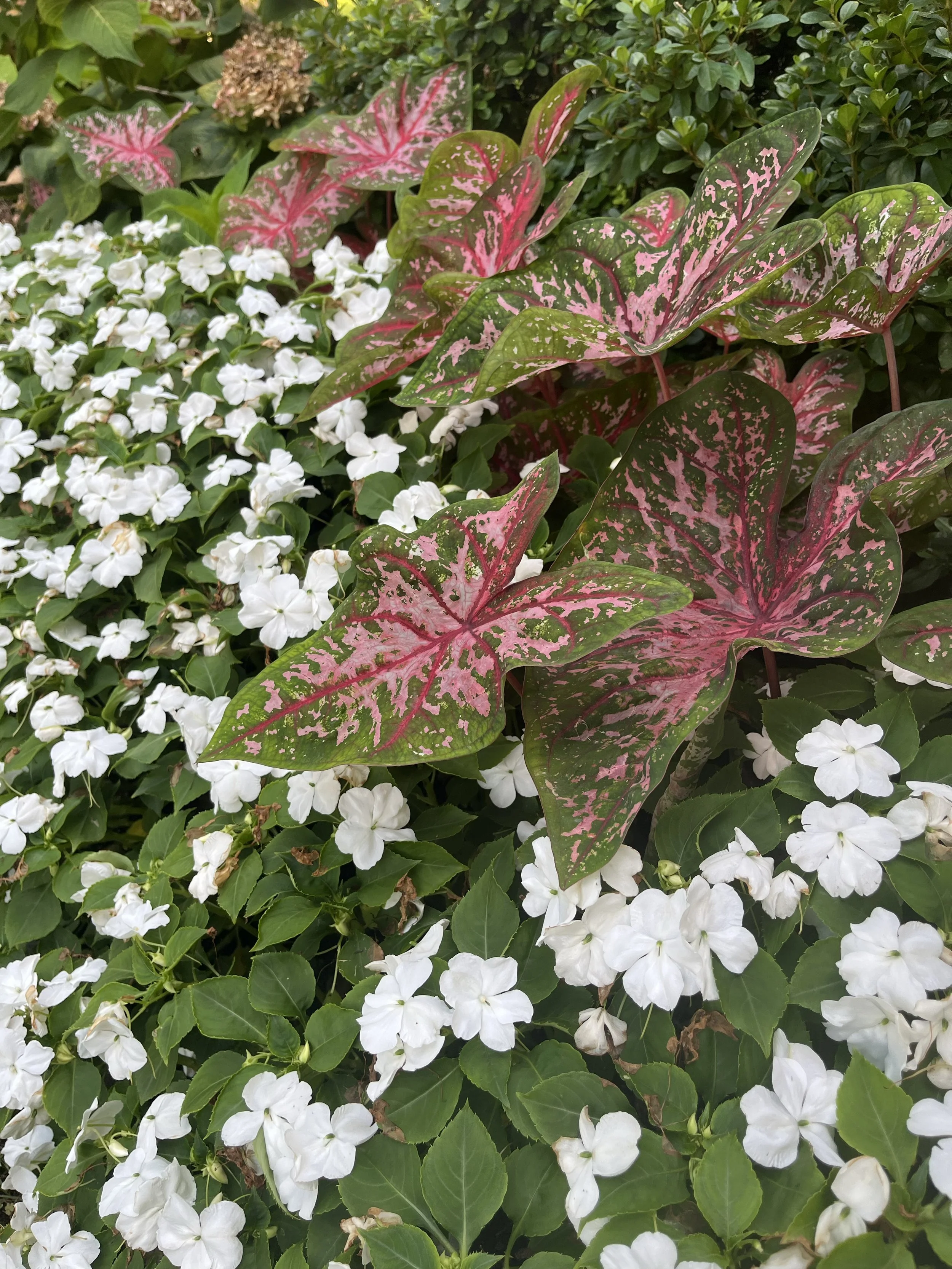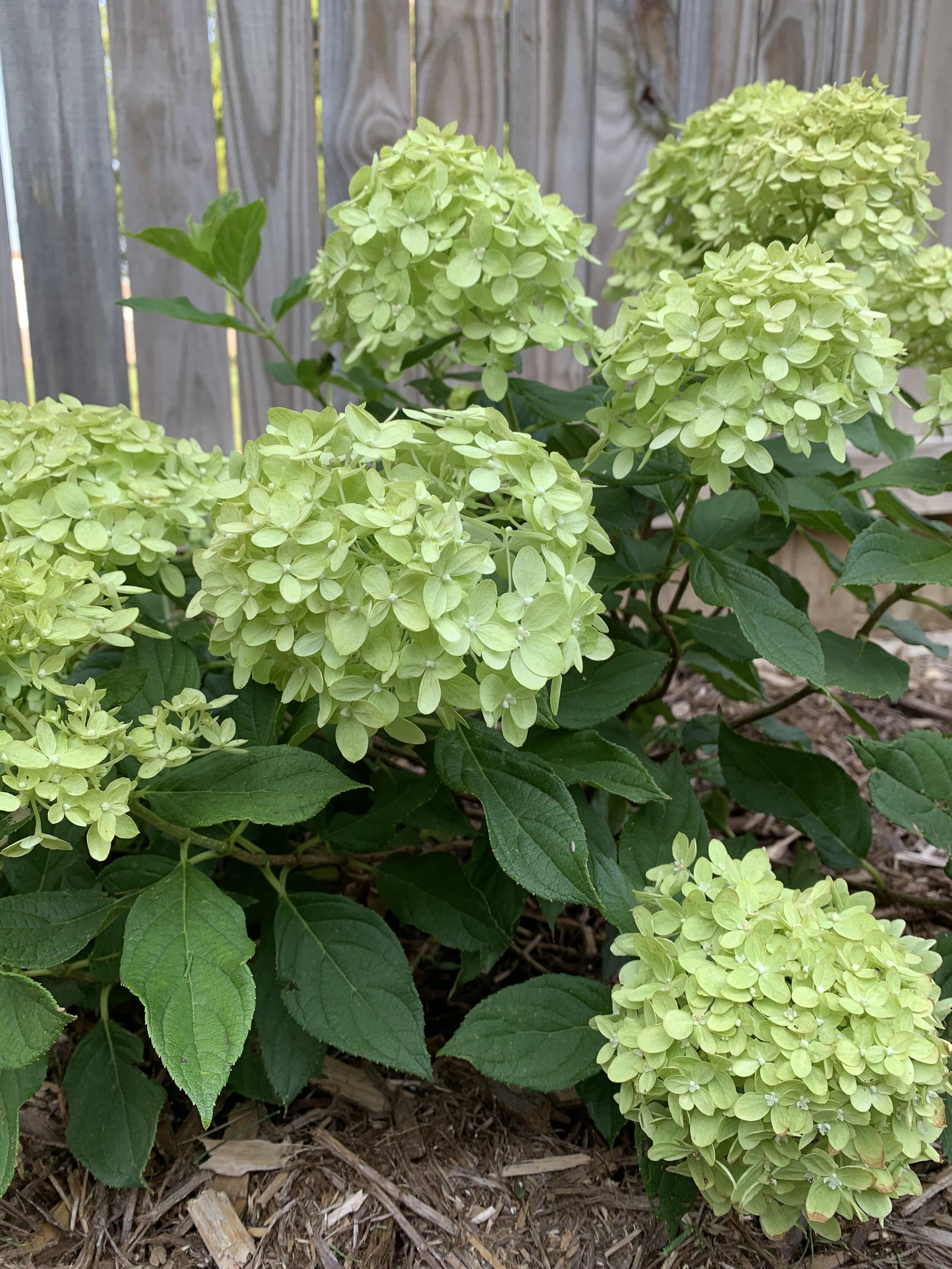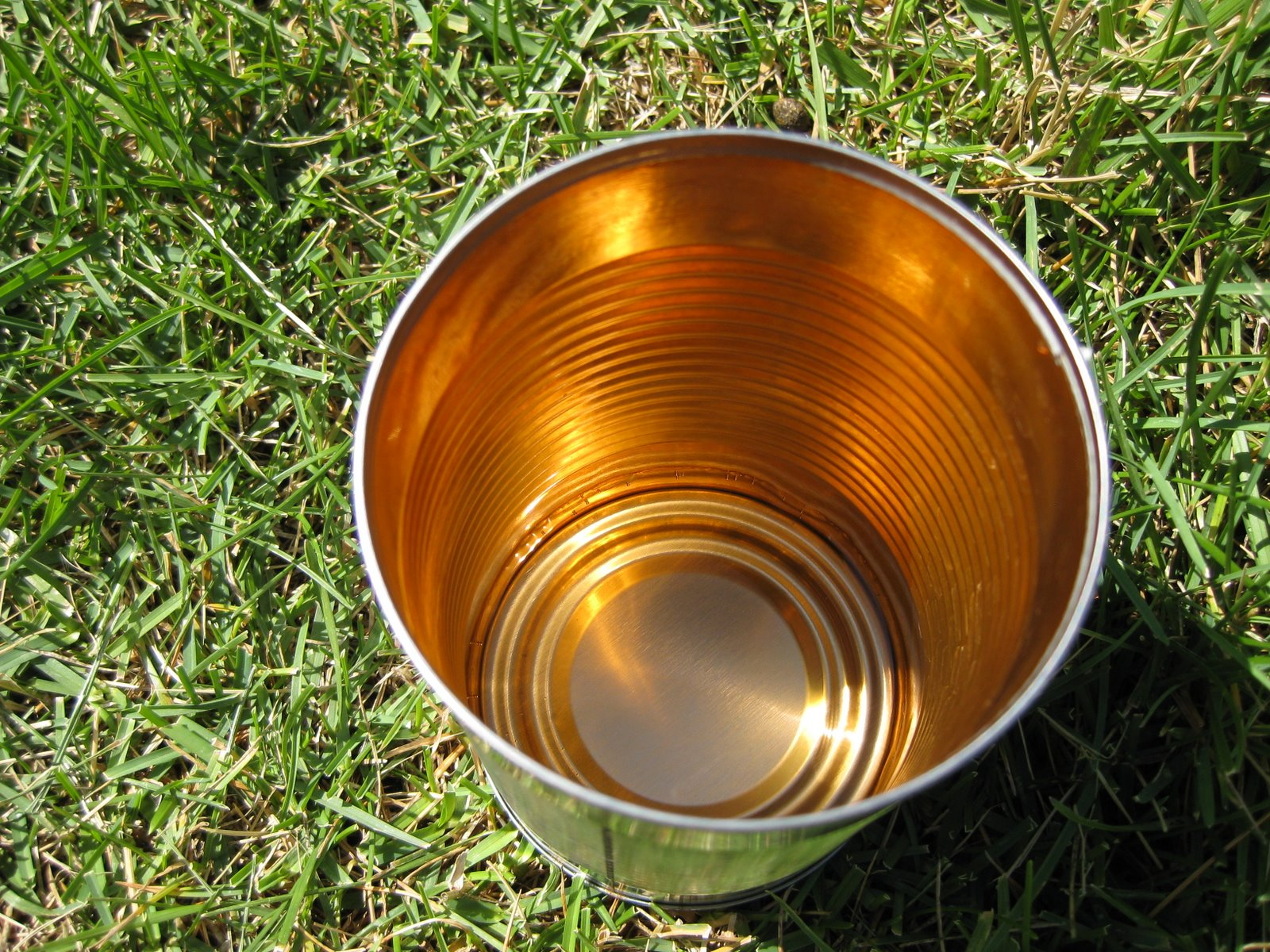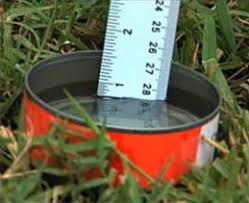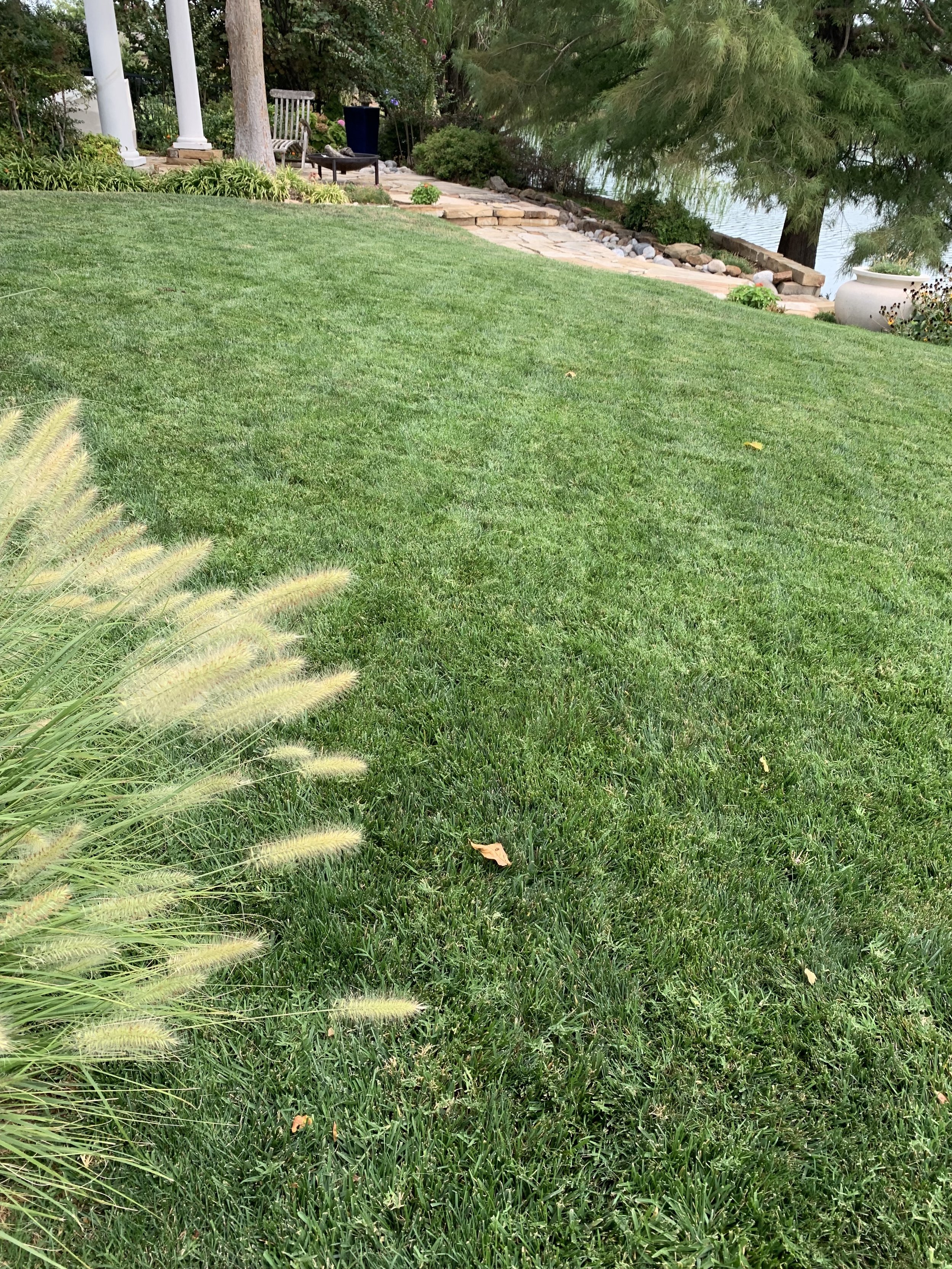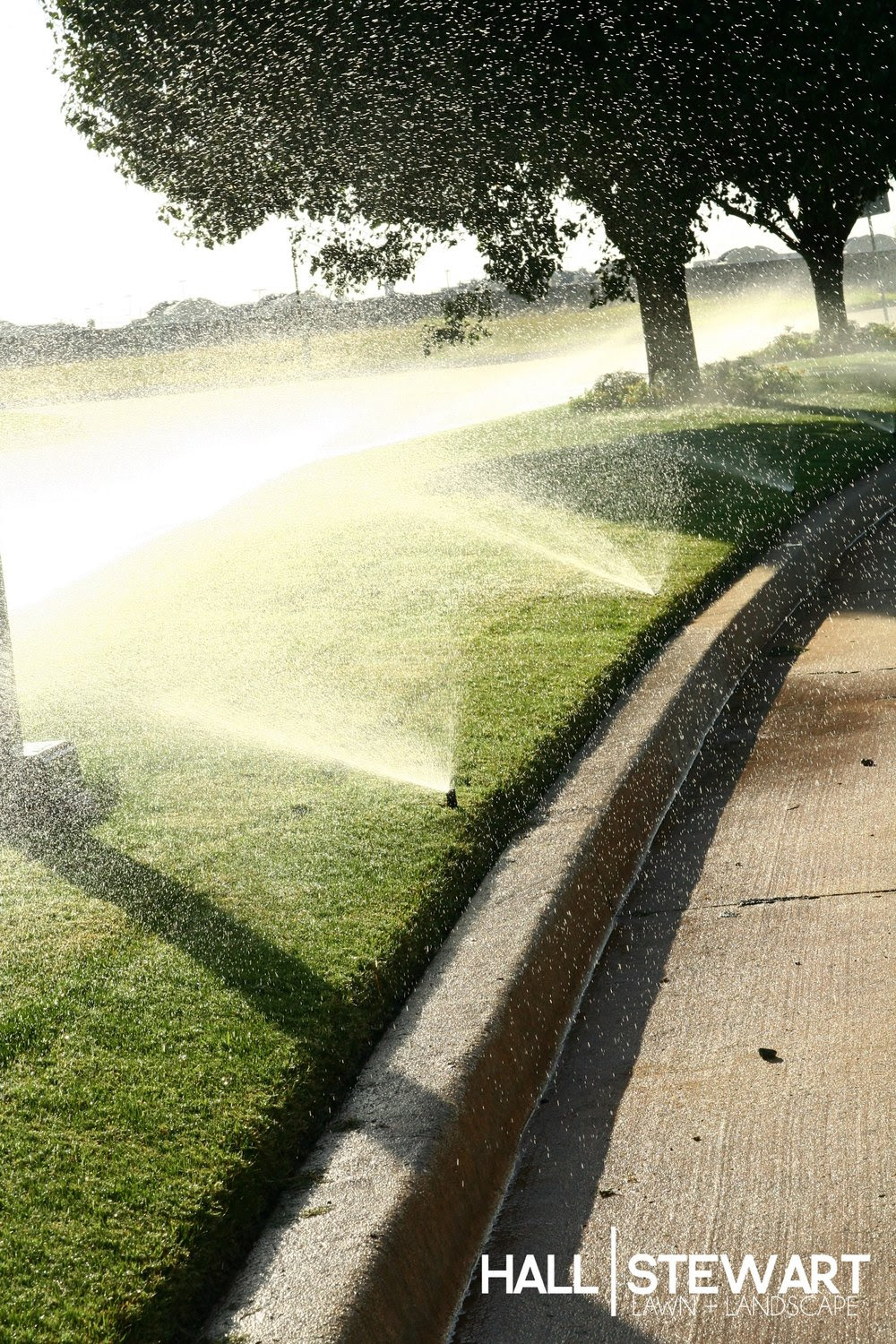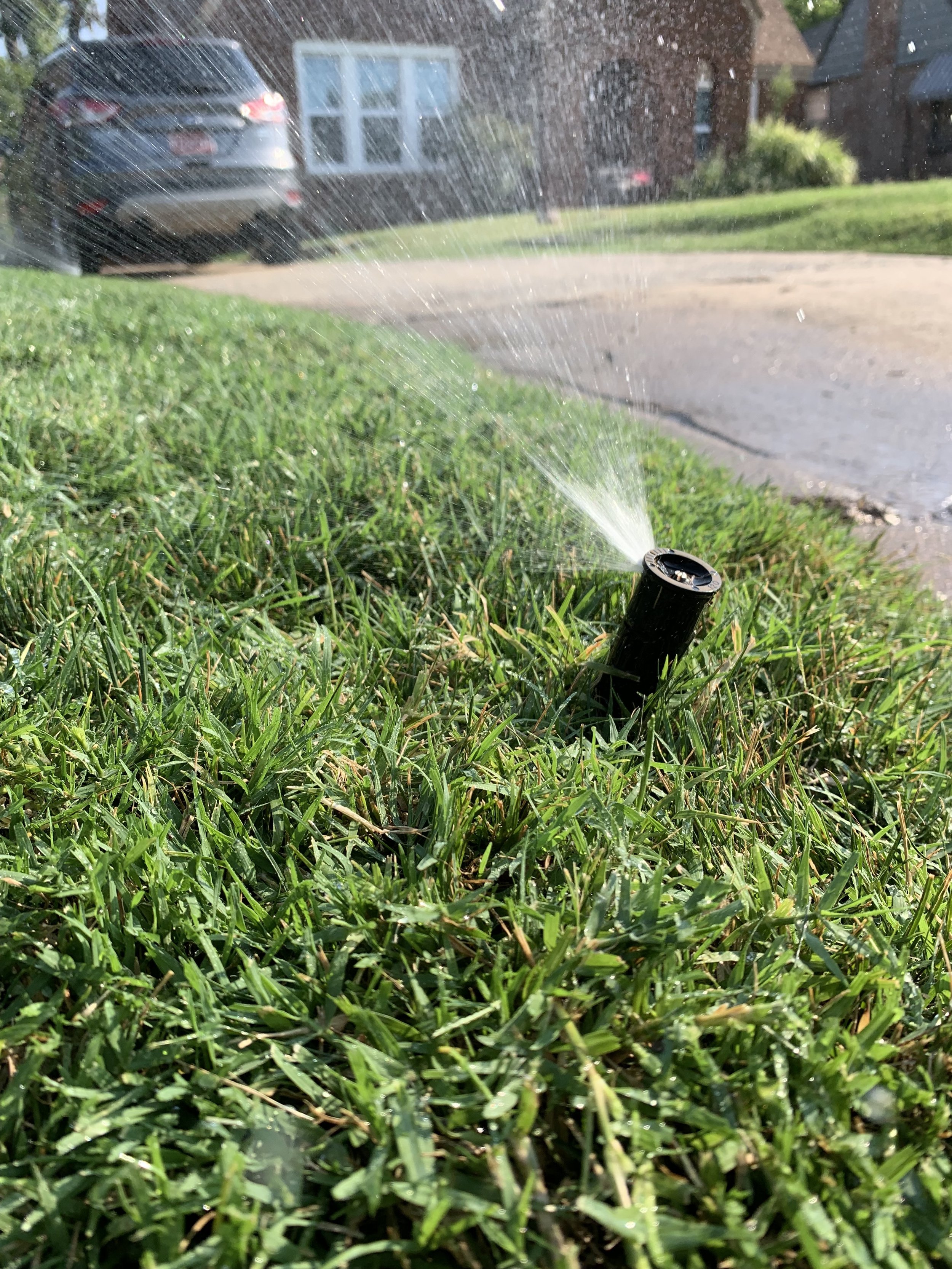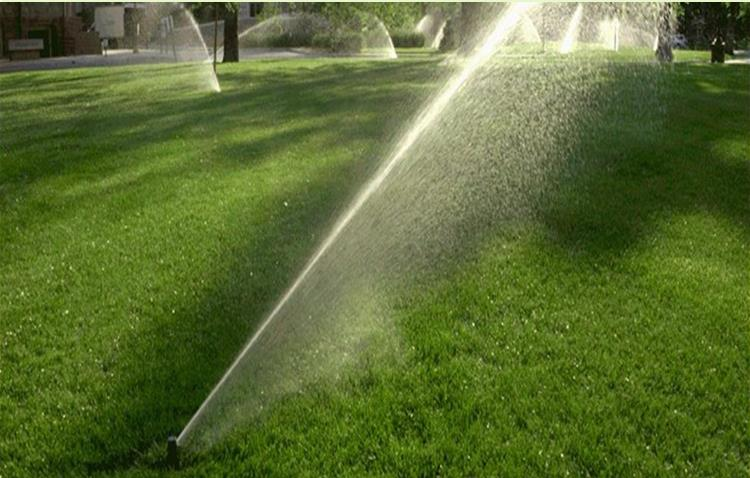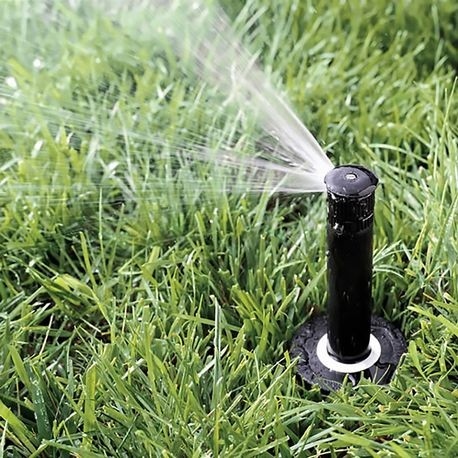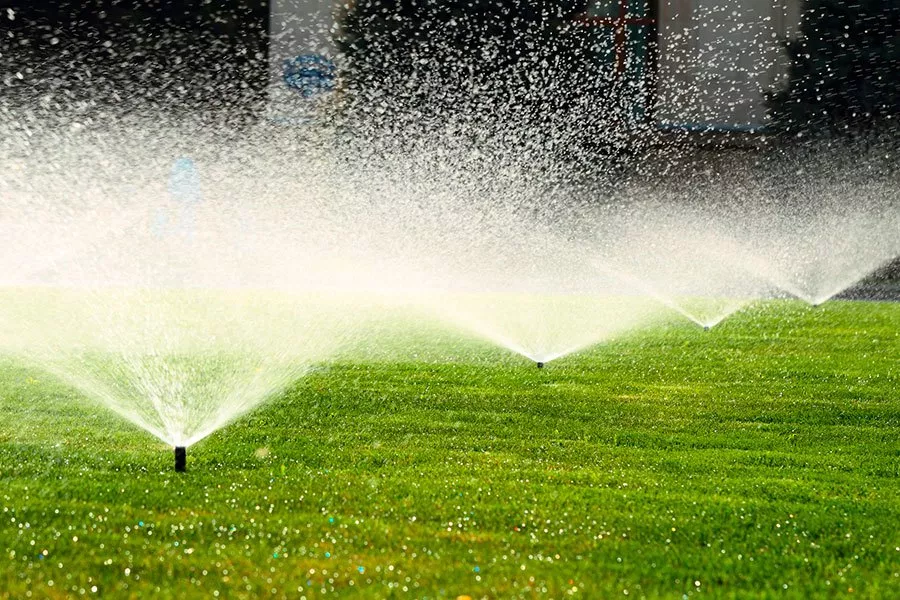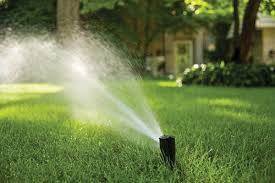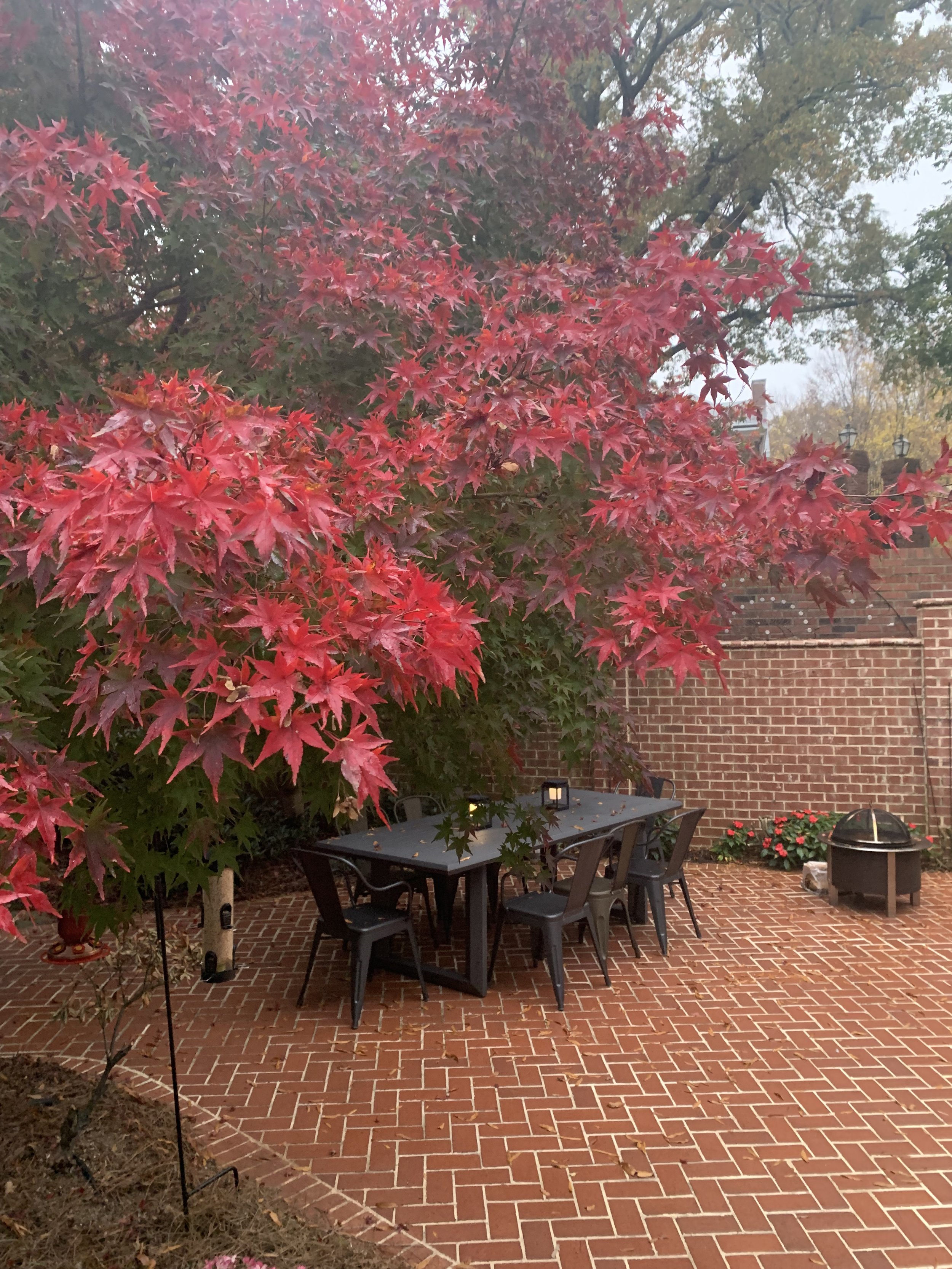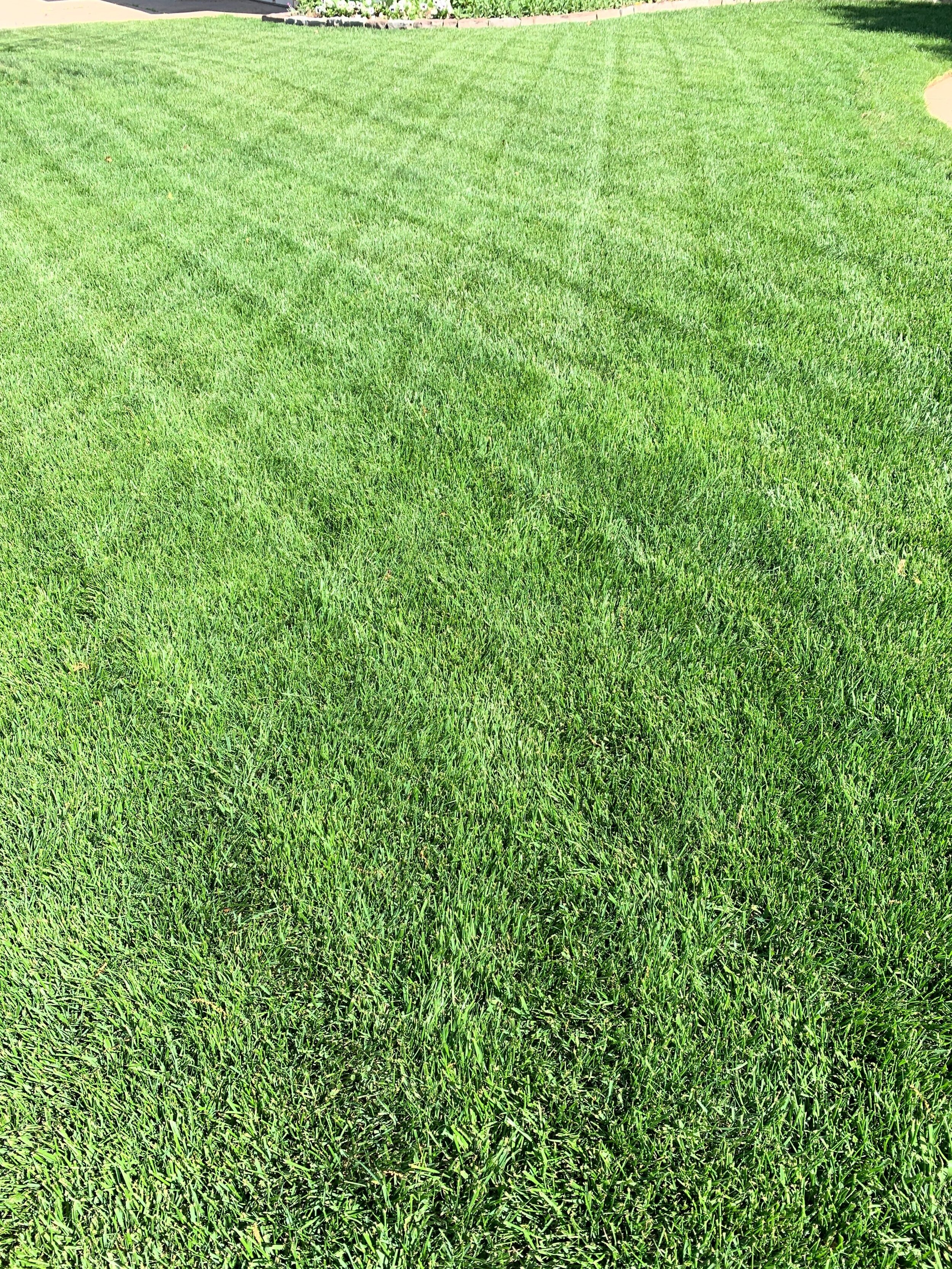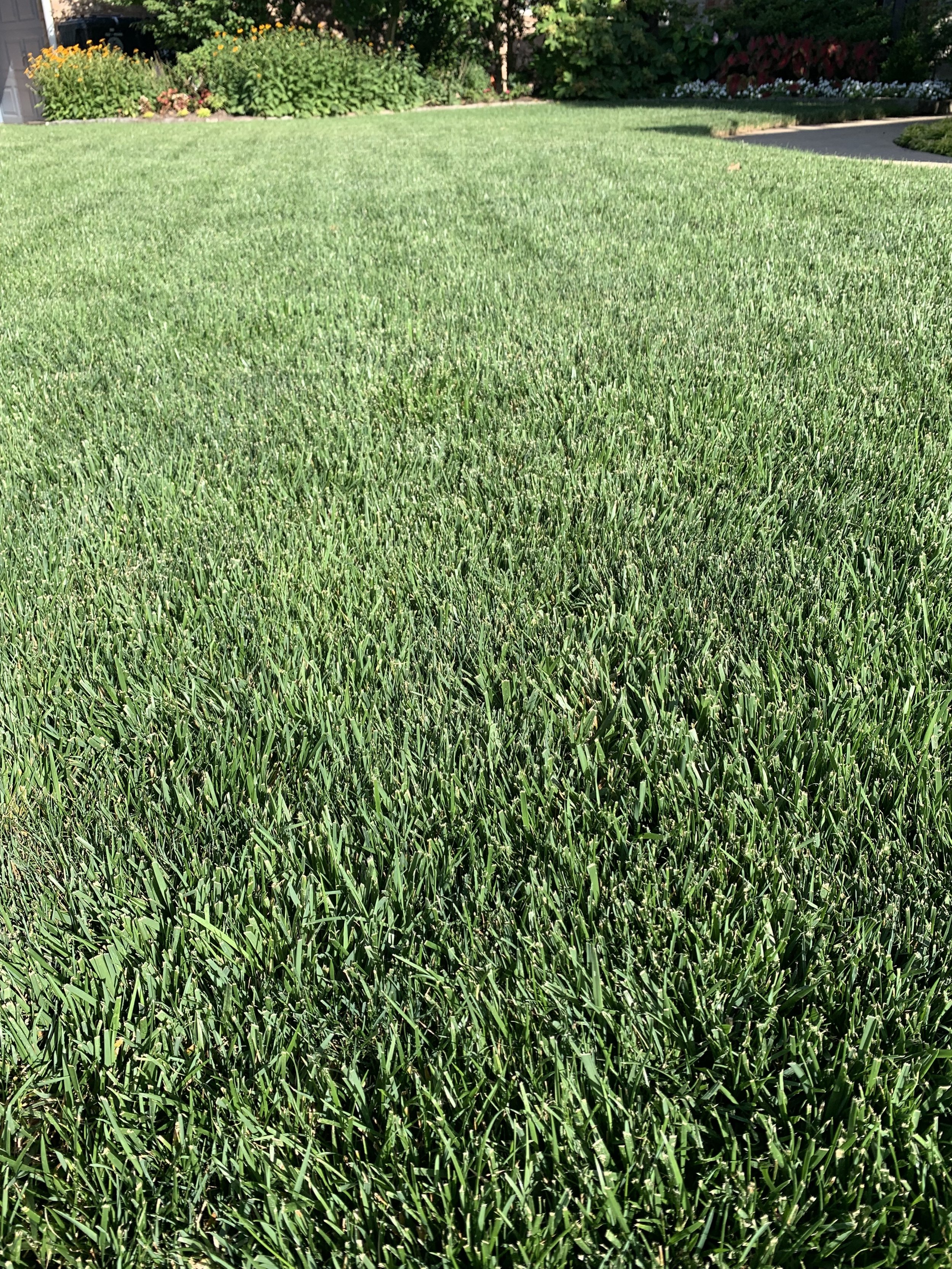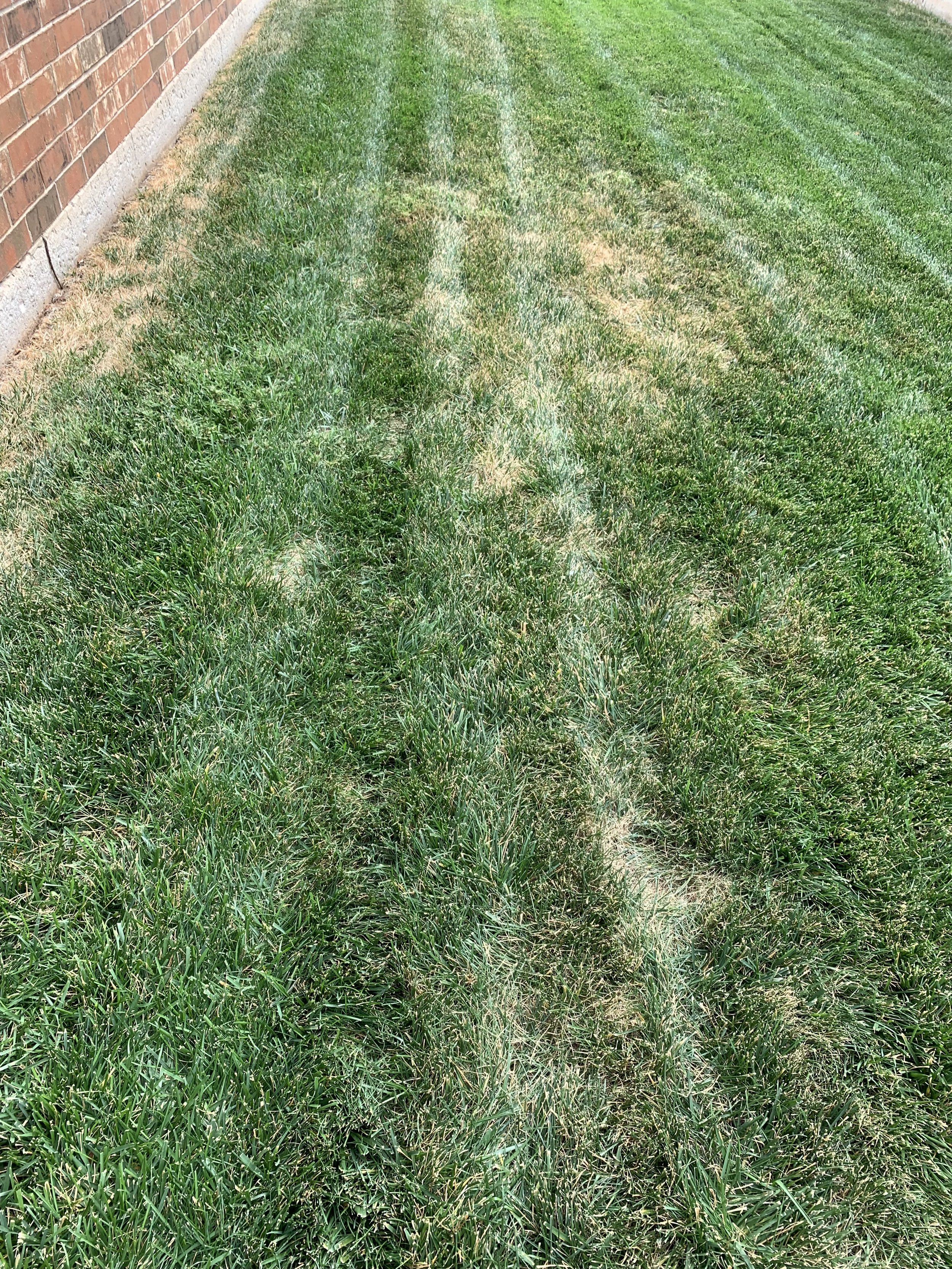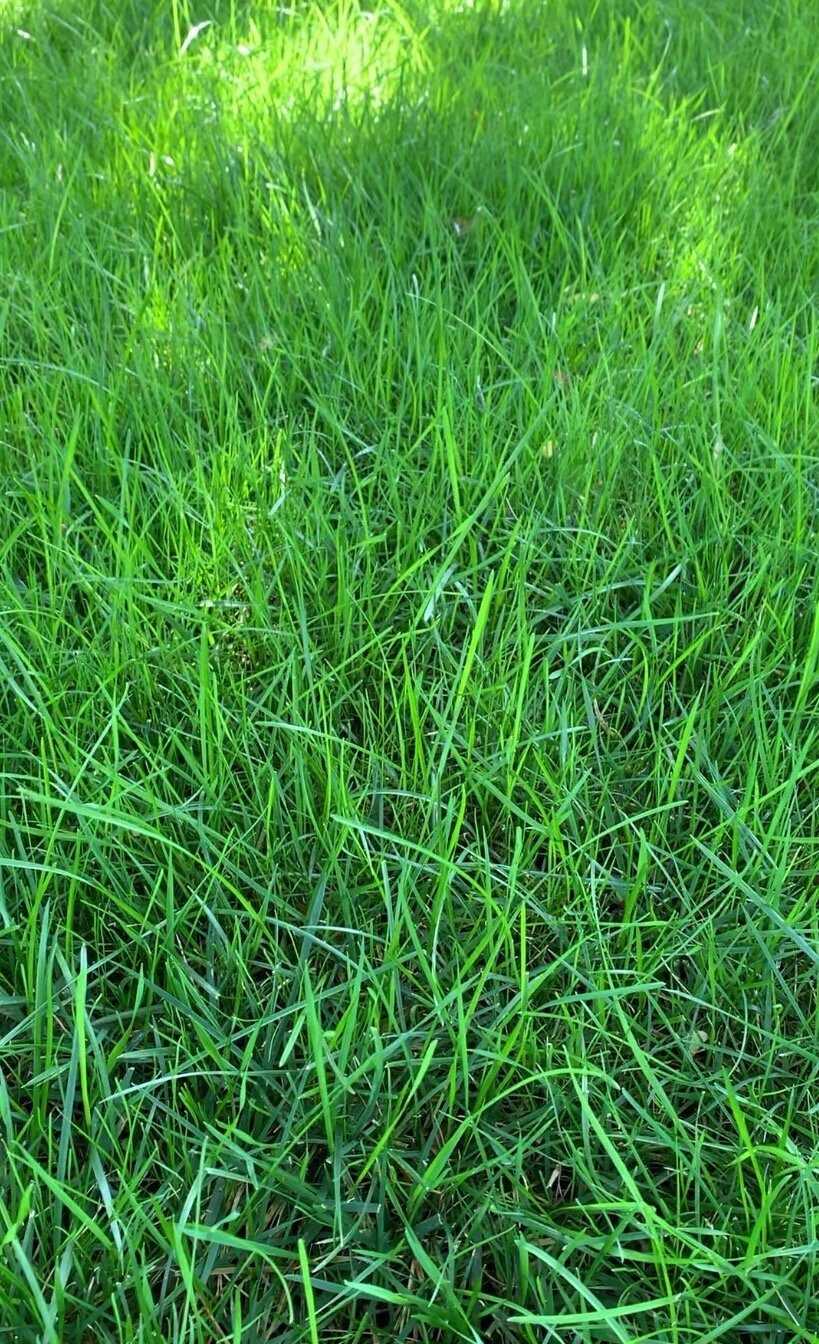
August Lawn & Landscape Tips
We have arrived at the hottest, driest point of the season…the last 10 days of July and the first 10 days of August when Oklahoma City’s average daily temperature reaches its peak.
The key to surviving the hottest period of the season is best practices. It's not just during times of high stress that these habits matter, but rather it's best practices all the time that make the real difference.
After getting way ahead on rainfall from mid-April through early July, the rainy pattern shut off three weeks ago. Hopefully, the chance of a good rainfall today will materialize and break the 21-day streak of no rainfall we currently have going.
Lack of moisture is the current biggest issue we are seeing. This week alone, we visited a lot of lawns and landscapes that were desperately needing moisture, with irrigation controllers still set as if we were getting occasional rainfall.
To finish the summer strong and keep your lawn healthy, here are a few best practices to focus on, the first being watering:
Watering
The abundant soil moisture from the early summer quickly disappeared the past two weeks. The best-looking lawns and landscapes are those that are receiving 1 ½” of water per week.
To learn how long and how often you need to water for your landscape to receive 1 ½” of moisture, place your Hall | Stewart Rain Gauge or cans around your lawn. Water using your normal cycle and then check the cups. Adjust watering times and frequency accordingly to insure 1 ½” is applied each week. Remember your landscape prefers deep soaking, infrequent watering over shallow, frequent watering. Even in the heat, lawns and landscapes are at their best when they are watered deeply as needed and not every day.
Healthy lawns have deep root systems. Roots will grow to the moisture. If your watering pattern is short, shallow, frequent watering resulting in moisture only in the top 1-2”, you will have a shallow rooted lawn dependent upon daily water. Deep soaking results in a root system with grass roots 6” to 2’ deep that is not dependent upon frequent watering and is drought resistant.
Remember, trees planted in the last two years need supplemental watering during the summer heat and extended dry periods. A good rule of thumb is to give them 10 gallons of water every week.
Best Watering Practice for August – Know how long you need to water to get 1 ½” water on your lawn each week. Practice deep soaking, infrequent watering.
If you are unsure about your watering practices, let us help. We can schedule an Irrigation Audit/Check to make sure your system is operating at its peak efficiency during the summer heat.
Take time to check your irrigation and fine tune it. A leaning head often is the culprit for dry spots in the lawn.
I am currently mowing my fescue lawn at 3 1/2". More leaf space results in better heat and drought tolerance.
Mowing
Both warm season turf (Bermuda and Zoyia) and cool season turf (Fescue) should be mowed at the highest level this month, warm season 2-2.5” and cool season up to 3-3.5”. At the higher level the lawn will have more leaf space resulting in better heat and drought tolerance. Continue to mow often enough that you are removing only 1/3 of the grass each time you cut. If you are cutting frequently enough to pass the 1/3 test, don’t catch the clippings. Allowing the clippings to decompose on the lawn will return moisture and nitrogen to the soil. Give no bagging a try. You will be surprised at how much more color your lawn will retain even in the heat. When you bag your clippings, you are tossing out nitrogen and moisture your lawn could really use this month.
Best Mowing Practice for August – Mow high, mow often, and don’t bag your clippings.
Bermuda lawns perform their best in the heat. Mow often and don’t bag the clippings. Grass clippings are mostly nitrogen and moisture. Your lawn will thank you for giving them back.
After mulch mowing, use your blower to distribute any noticeable clippings.
Well maintained Bermuda lawns can’t be beat in August. This Bermuda lawn is the result of best practices this summer: well timed lawn care applications, aeration in June, deep infrequent watering, and mulch mowing.
Fertilizer
Apply fertilizer to warm season turf this month. This time of the year, Bermuda and Zoysia benefit from a high nitrogen fertilizer that is low in phosphorus and potassium.
DO NOT fertilize cool season lawns until we reach the cooler temperatures of September.
Warm and cool season turfs require different fertilizer schedules. Don’t make the mistake of trying to treat them the same when it comes to fertilizing.
Best Fertilizer Practice for August – Fertilize bermudagrass, don’t fertilize fescue. Important - Follow watering instructions after fertilizer is applied.
August is the month to be less aggressive on weed control. Because a thick turf is the most important part of good weed control, you want to avoid weakening the turf going into the fall.
Weed Control
Spring pre-emergent herbicides are reaching the end of their effectiveness in your soils. Should an occasional weed show up in your turf this month, it is best to go easy on weed control. We have reached the time of the year that damaged turf may not have a chance to fully recover before fall. Great weed control is at least 75% the result of thick turf. August is the month to focus on turf development going into the fall.
Later this month is the best time to start applying the first fall pre-emergent herbicide application. The first fall weed to germinate is poa annua (annual bluegrass). Poa annua has become more and more of a problem to control in lawns worldwide as it has developed resistance to current herbicide chemistry. For the best prevention, it is important to put a pre-emergent on your lawn between late August and the end of September followed by a second pre-emergent, using a different herbicide, in October or November.
Best Weed Control Practice for August – Don’t cause turf damage by overtreating weeds. Better to go into the fall with a thick turf than one with herbicide damaged thin areas.
Bermuda vs Fescue in August
Bermuda (warm season turf) loves the summer heat. Fescue (cool season turf) prefers nights below 70 and days below 90. Healthy bermuda lawns look their best in the heat of the summer. Healthy fescue will retain color, although not as much as in early summer, and growth will slow.
Fescue where there is plenty of air circulation and dabbled sunlight typically looks best in the warm weather. Fescue lawns with heavy shade and little air circulation tend to thin from brown patch disease. Brown patch occurs in fescue lawns anytime the grass stays wet for 5 hours or more at a time and nighttime temperatures are in the 70s. During the hottest and driest time of the season, brown patch is often self-inflicted by watering your fescue in the morning and evening, a common incorrect watering habit on fescue lawns in July and August.
Brown Patch develops in fescue lawns that have an area of low air circulation or heavy shade during the summer if the area stays wet for more than 5 hours at a time. Don't create Brown Patch with your watering practices. Allow your fescue time to dry between waterings.
Inspect Shady Lawn Areas
September through October is the best time of the year to establish fescue. Now is the time to assess the areas of the lawn where bermuda has become thin due to increasing shade (Bermuda needs at least 6 hours of direct sunlight to be thick), areas of the lawn where fescue did not perform well because of very dense shade (Fescue needs at least some dappled sun), and areas of fescue that have been damaged by brown patch this summer. Because fescue does not spread, you should plan on adding some seed every fall.
Best Fescue Lawn Practice for August – Inspect and evaluate your turf. Check shade patterns and make a plan for overseeding low light areas with fescue this fall.
Need Help Evaluating Your Shady Areas?
We would be happy to evaluate your shade and make a recommendation.
Just give us a call at (405)367-3873 or respond to this email.
Insect Watch
If Grubs have been a problem in your lawn, August is the time to apply an insecticide. Remember, the insecticide will kill desirable insects also. Only treat for grubs if there is evidence of a problem.
Keep on the lookout for Army Worms. We continue to find active army worms causing damage in isolated areas of the metro. There are 4 to 5 generations between July and November with each generation increasing in numbers, so early control is best. Early caterpillars are green and very small. As they grow to 1 to 1 ½” they turn browner with reddish brown stripes on each side of the body and small back spots on the top. Their distinctive mark is an inverted “Y” on the front of the head. Army worms will feed on any leafy, soft plant with plenty of moisture in the leaf. Typically, in August they will feed mostly on bermuda because of an abundance of healthy leaf blades and less on fescue because it is not flourishing as much in August. Watch for areas of the lawn that appear to have drought stress should not be. Test the area with a soap flush. Mix 1 teaspoon of dish soap with 1 gallon of water and pour over the surface. If you have army worms, they will come to the surface. Treatment with a systemic insecticide when the worms are small before they become heavy feeders is best. Need more information on Army Worms, check out our article from July 13th.
Continue to inspect shrubs for Aphids and treat as needed. A common host plant is the Crape Myrtle.
Inspect your trees and shrubs for active Bagworms. If you need help controlling bagworms, give us a call. When possible, remove and throw away bagworms. Don’t toss them on the ground because they will crawl back onto your plants.
Watch for Webworms in your trees this month. The later generations of webworm are the ones that cause damage. If noticed early when the webbing is small, simply cutting the branch out is the best control. If spraying is required, you must penetrate the webbing to gain control.
Best Insect Control Practice for August – Spend a few minutes inspecting your lawn and landscape for insect activity. Treat as needed.
A common problem on Hackberry trees in the summer is nipple gall. Unfortunately little can be done to control gall-making insects.
When you remove bagworms please dispose of them. This little guy is slowly climbing back up a tree to do more destruction.
Summer annual color mixture of Joseph Coat, Sunpatien, Angelonia, Penta, Coleus, and Lantana.
This summer’s Crape Myrtle colors have been brilliant.
Lantana
Shady summer annual color mixture of Impatiens and Caladium.
Limelight Hydrangeas can’t be beat for colorful summer shrub. This is a ‘Little Lime’ and is great for smaller areas.
Landscape Color
How has the color been in your landscape this season? Sometime this month take pictures and make notes of the plants that are doing the best in your landscape.
Black-eyed Susan’s are the perfect perennial to add color to the landscape during July and August.
Crape Myrtles are loving the warm days and rewarding us with abundant summer color this year.
Limelight Hydrangeas continue to brighten the landscape even on the hottest of days.
Lantana, Penta, and Periwinkle are just a few summer annuals that are at their best now.
What is adding great color to your landscape right now? We want to know. Send pictures please.
Lantana is one of the best heat-loving annuals and with so many varieties, there is a right one for every landscape.
Angelonia is becoming a favorite summer annual. It has profile spikes of color and is available in white and shades of pinks and purples.
Crape Myrtle and Black-eyed Susan’s are a great color combination for late summer color.
Limelight Hydrangeas continue to add large white blossoms to the summer landscape.
Coleus is a great summer annual with big colorful leaves that at interest to the summer landscape.
Black-eyed Susan’s add a splash of bright color to the hot summer landscape.
Lantana is one of the best annual color plants for a summer filled with above average temperatures.
Brake Light Yucca are a fun addition to the summer landscape.
Shasta Daisies are nearing the end of their summer color show.
The best perennial plantings are the ones that have something blooming spring to fall. I challenge you to find another perennial that puts on a better color show in August than Black-eyed Susans.
Periwinkle is a lover of the summer heat.
Keep faded blooms pruned off and you will extend their bloom time a few more weeks.
August is a great time to evaluate your summer annual color and make notes on what worked and what didn’t. This planting of Sunpatien, Begonia, Penta, Joseph Coat, and Melampodium started the summer looking great. But over the last few weeks the Melampodium has over powered the rest of the color. Note: “If using Melampodium plant it in the back.”
Endless Summer Hydrangeas will add more blooms this month.
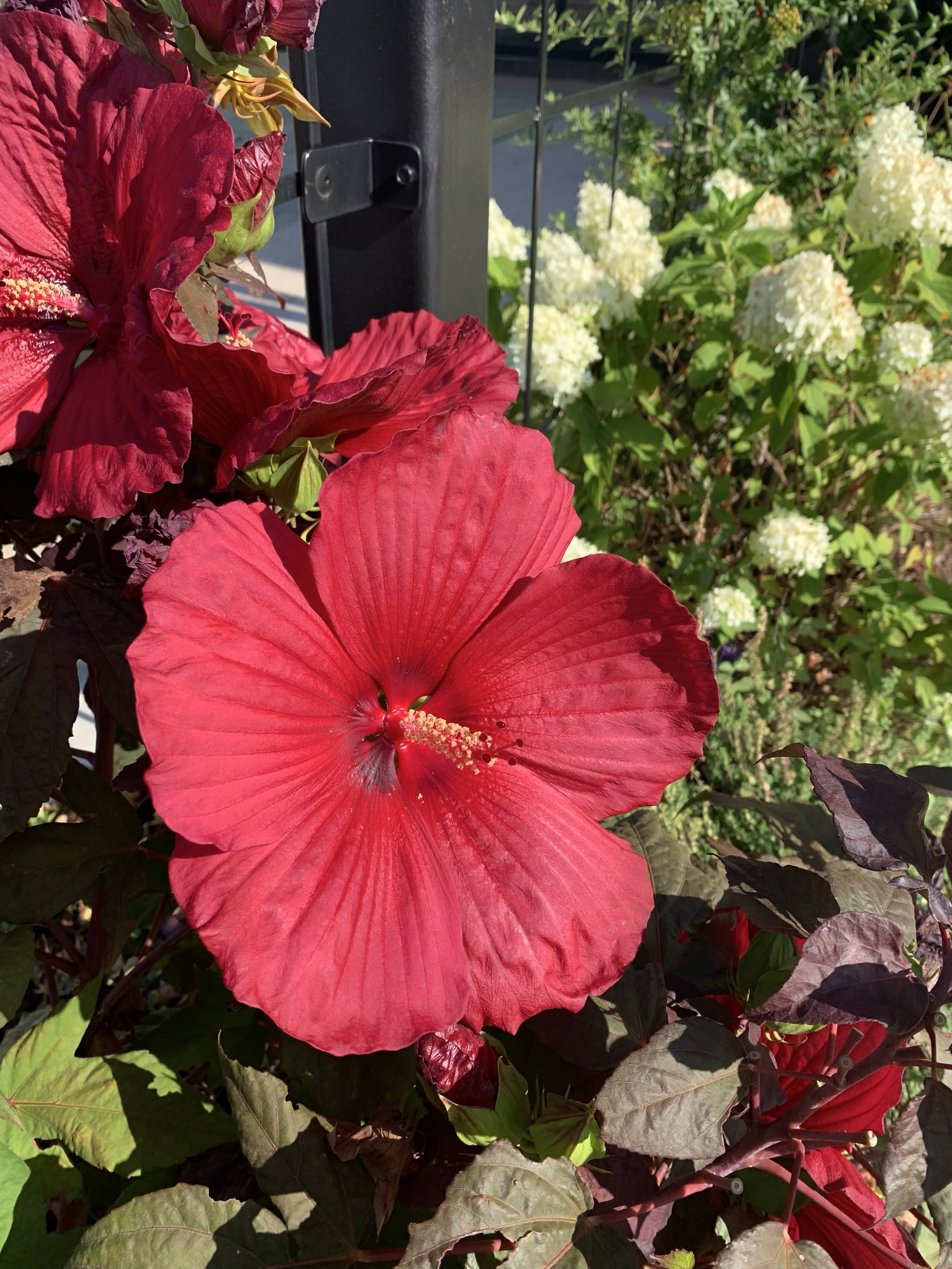
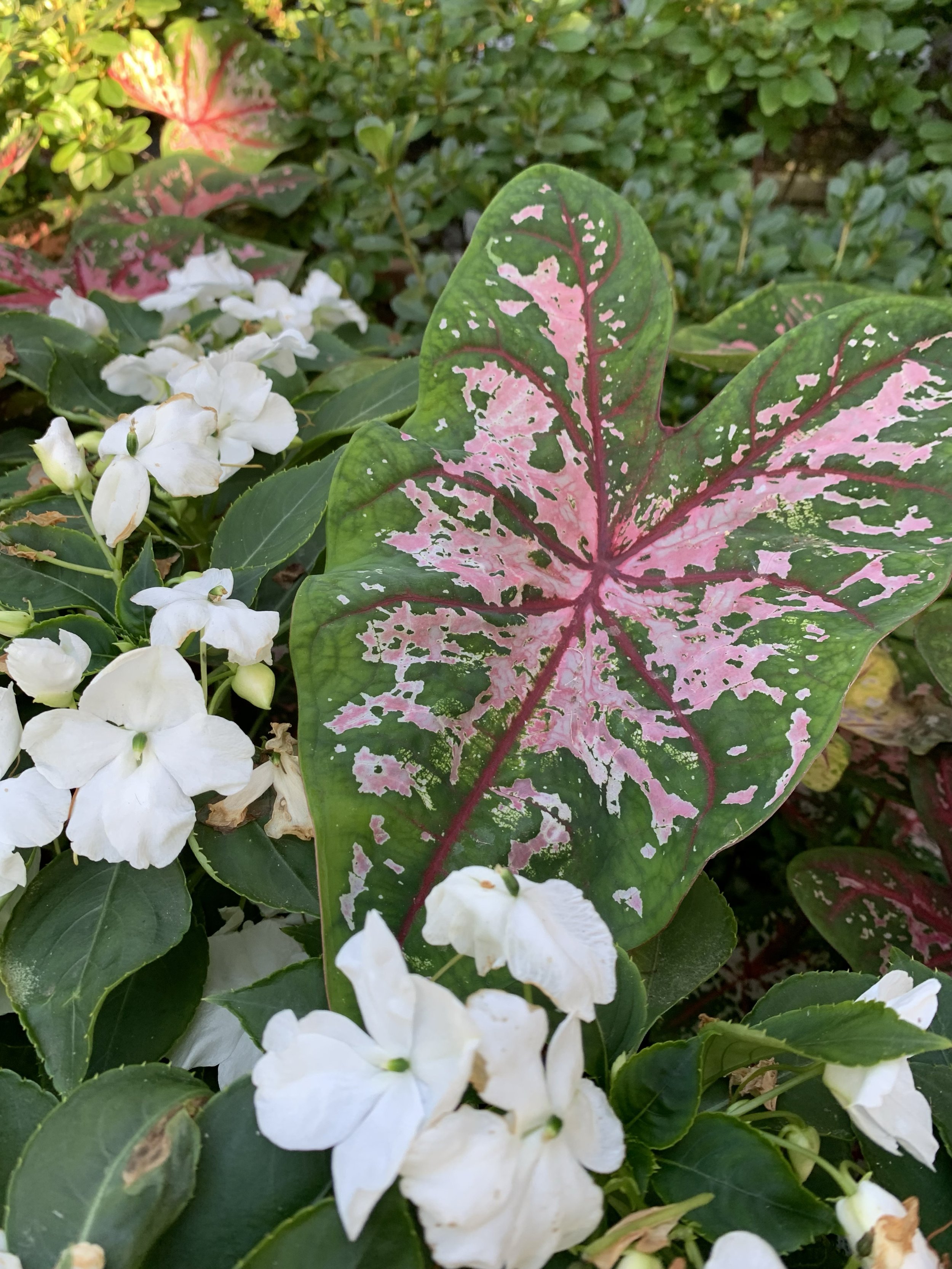
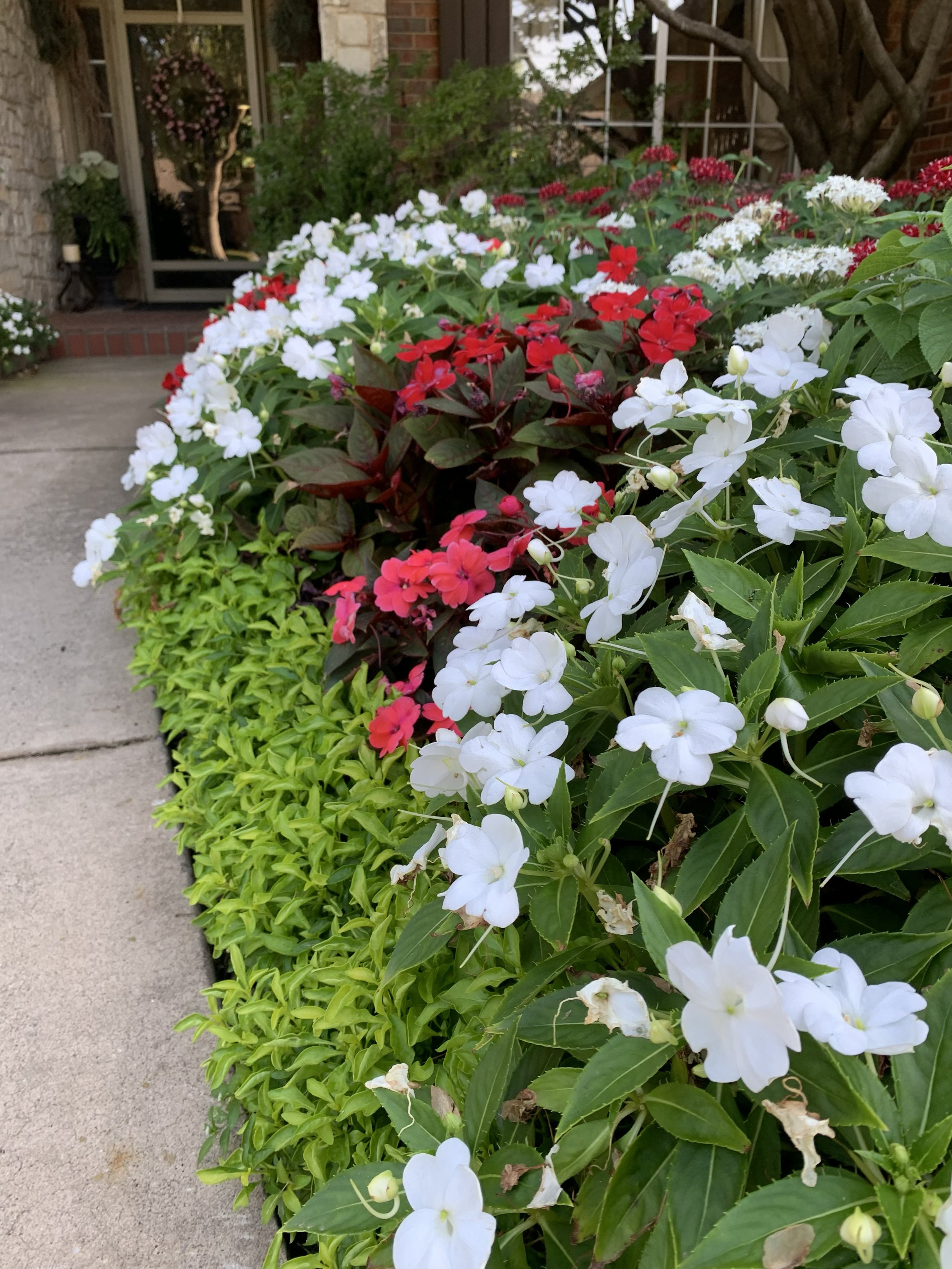
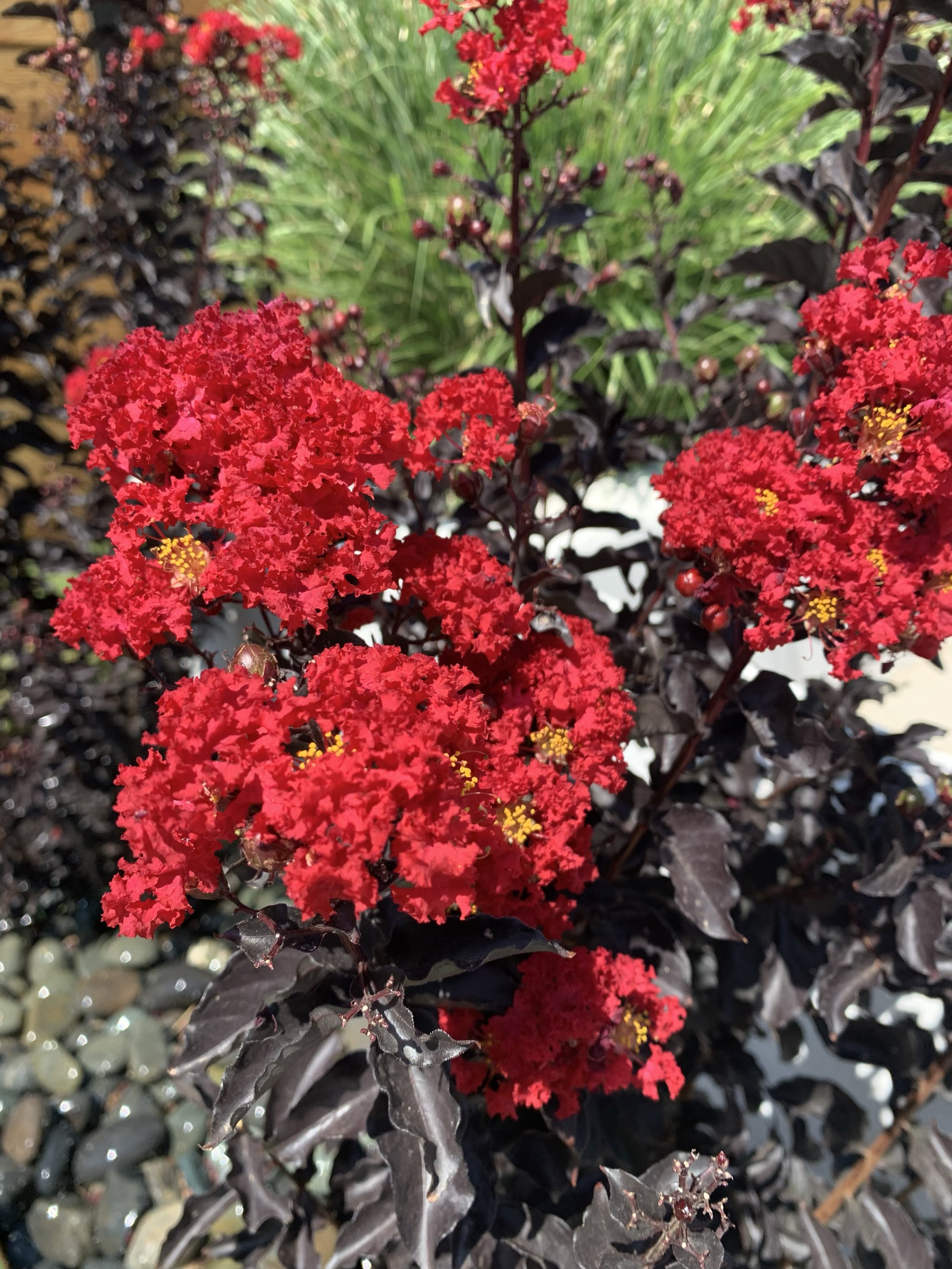
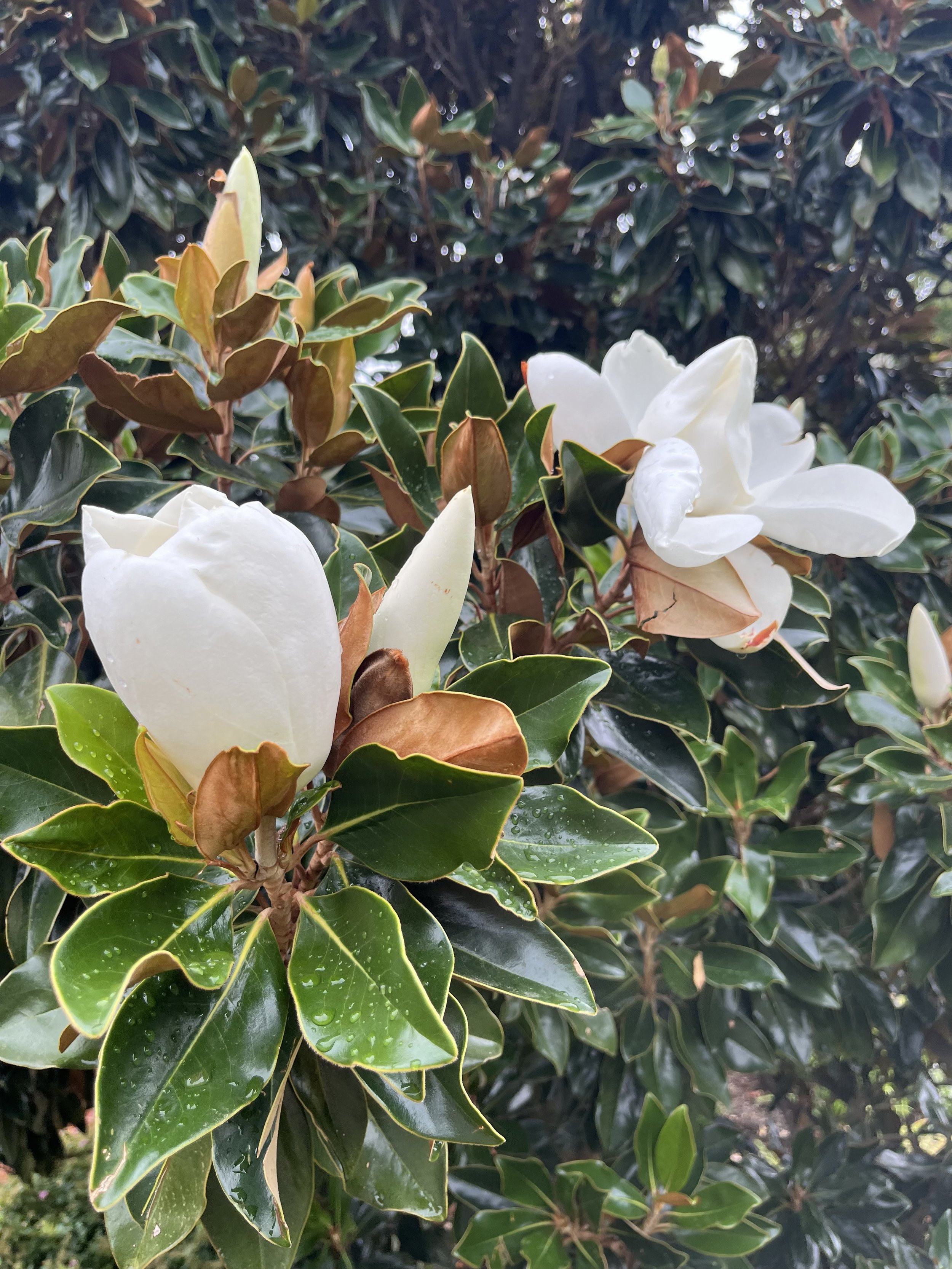
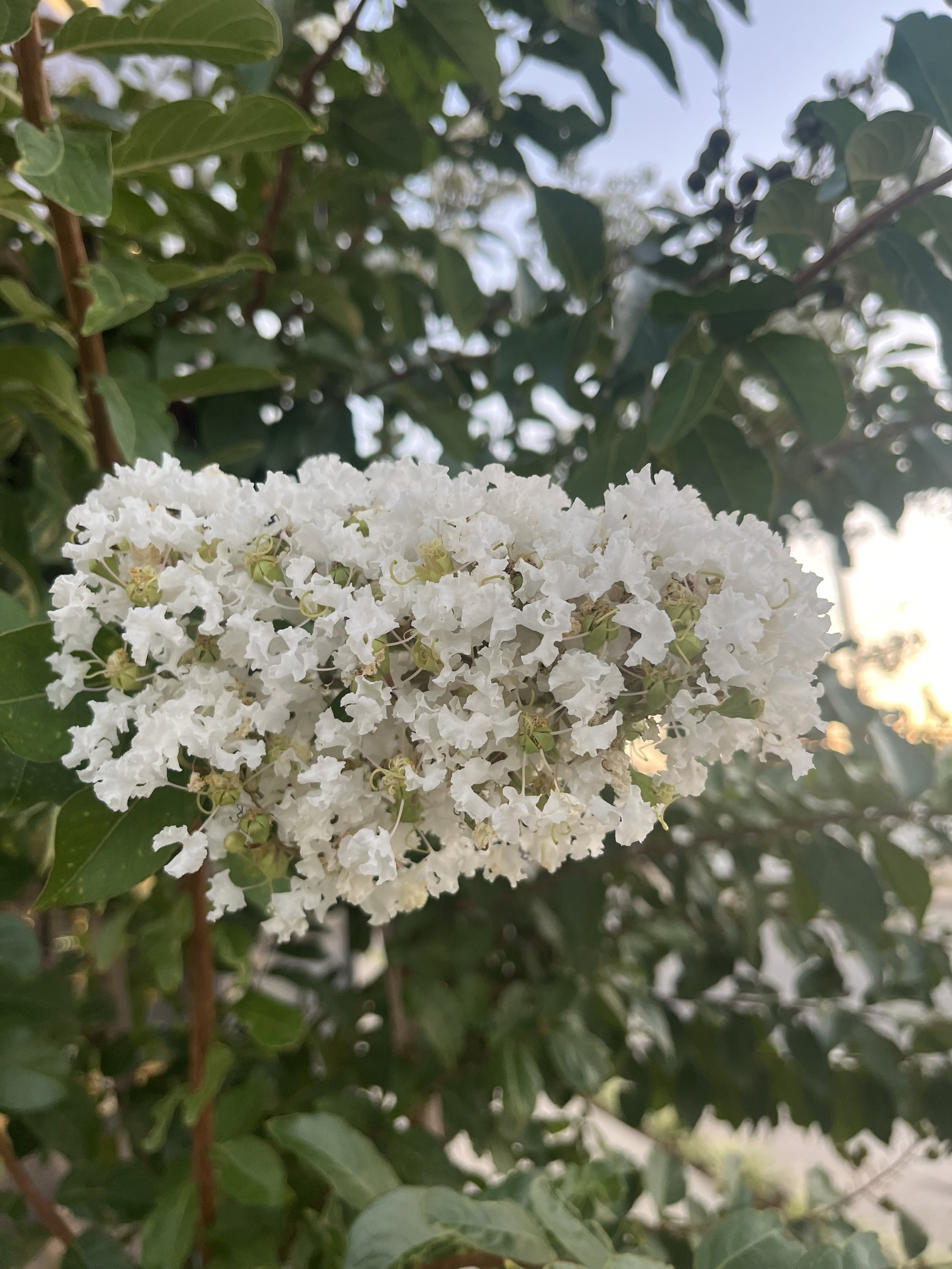
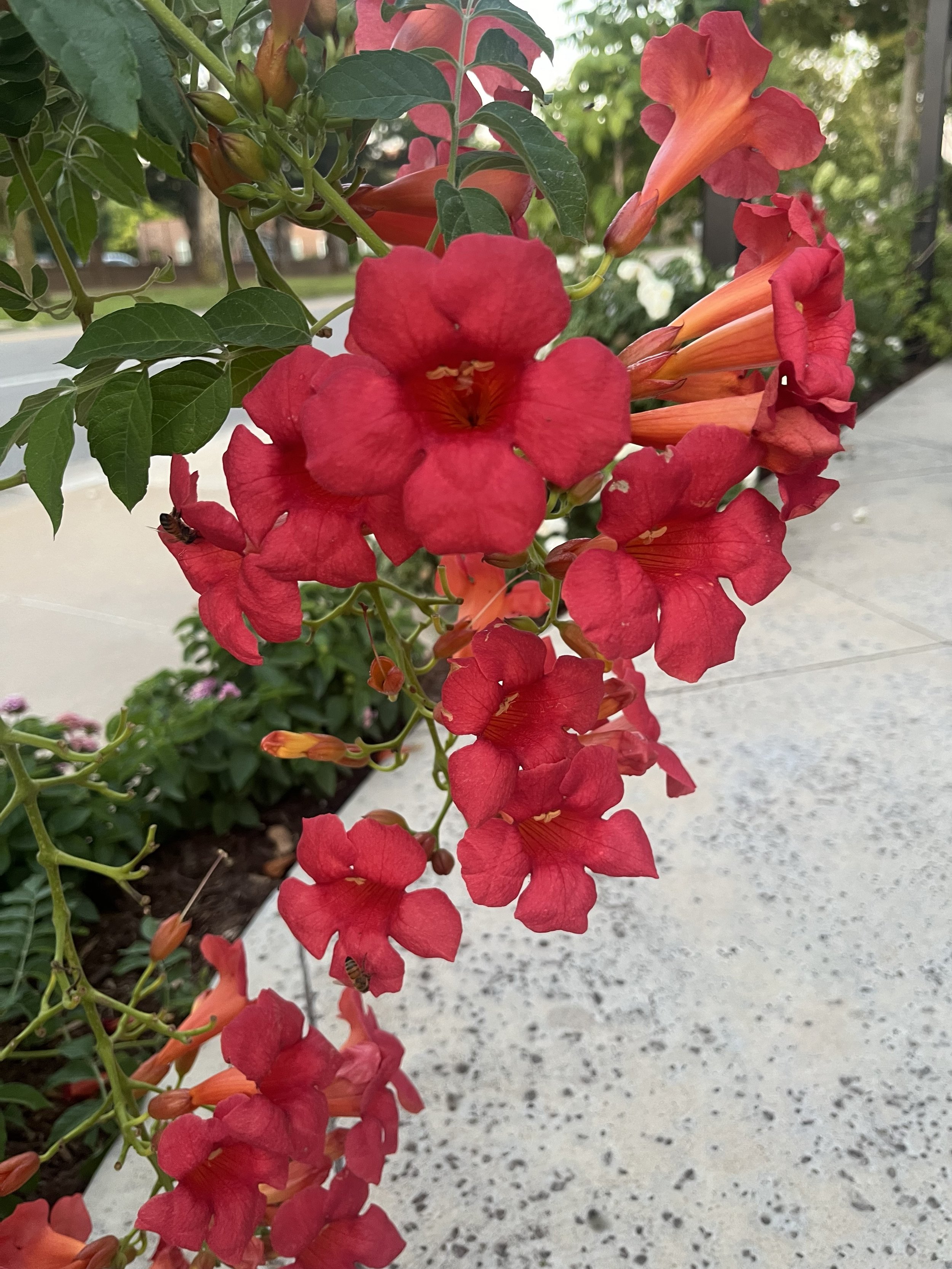
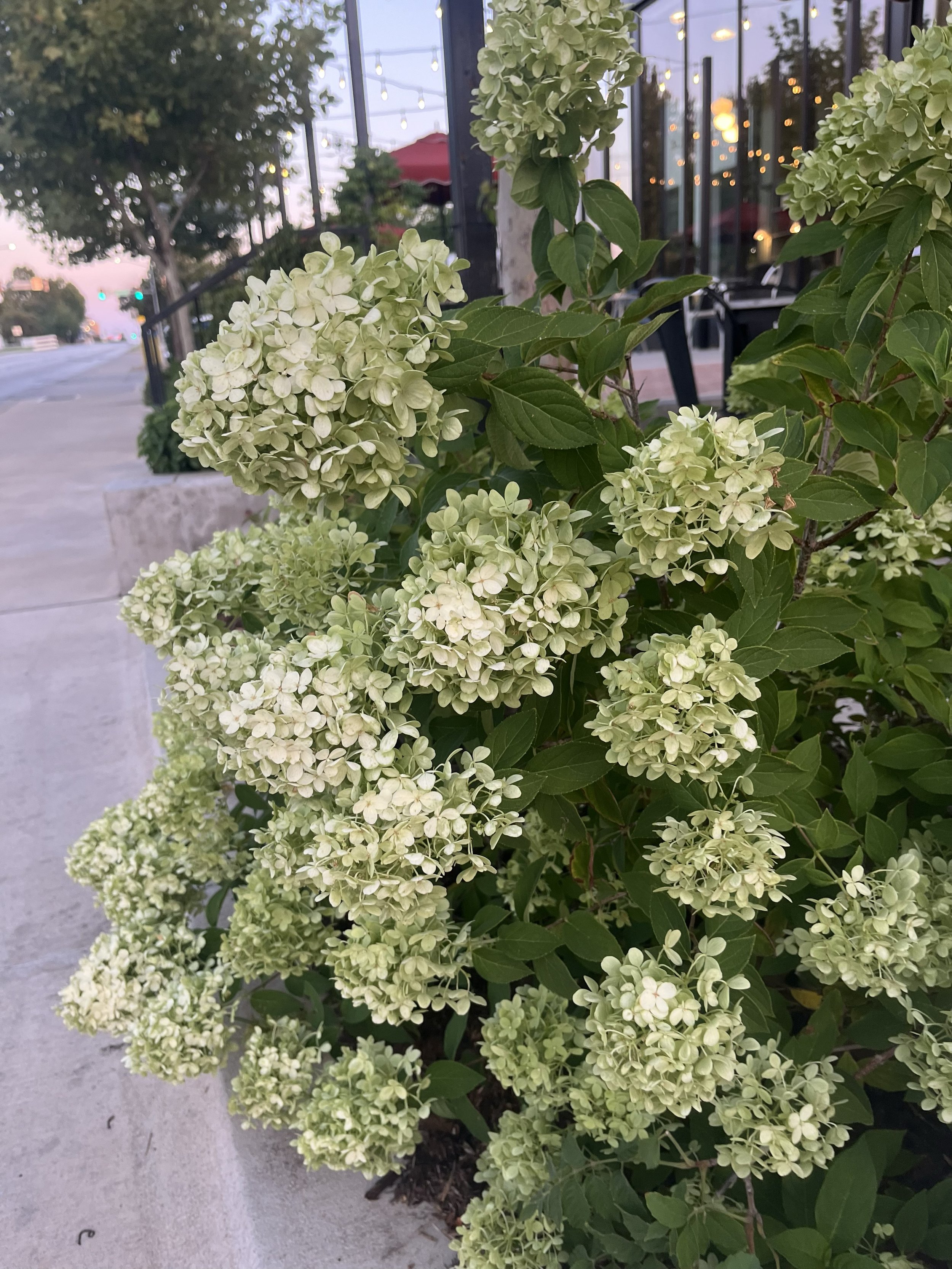
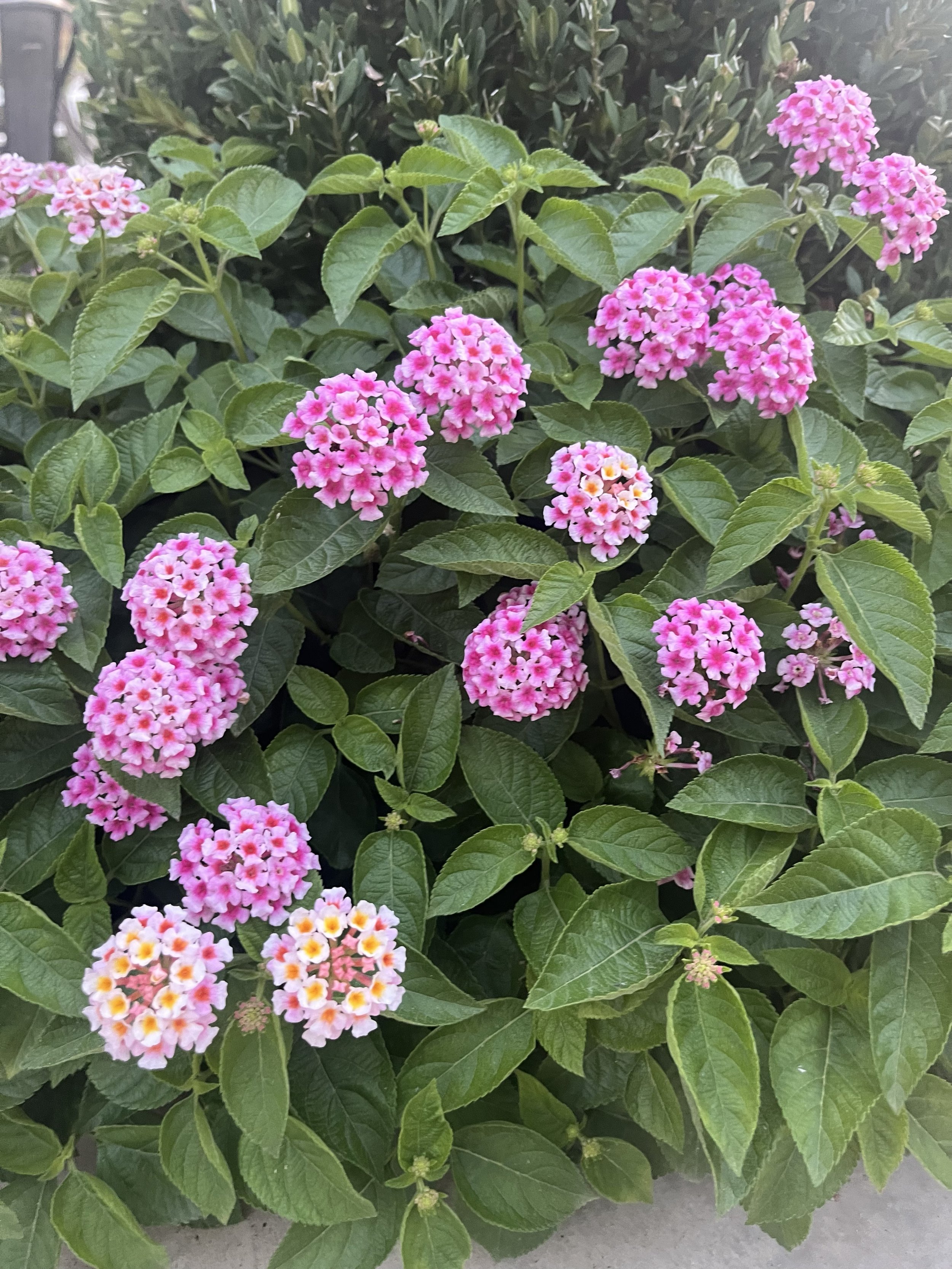
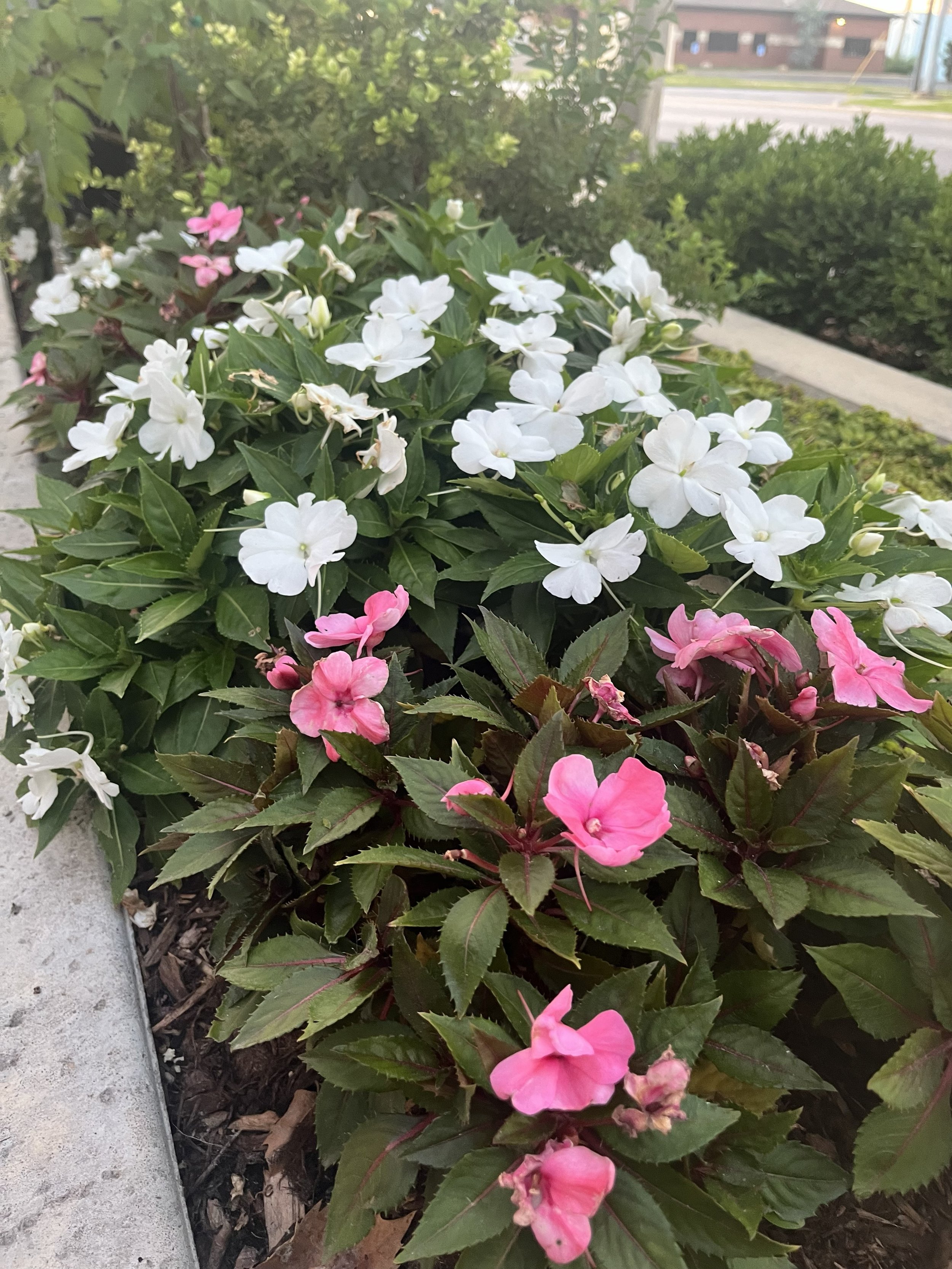
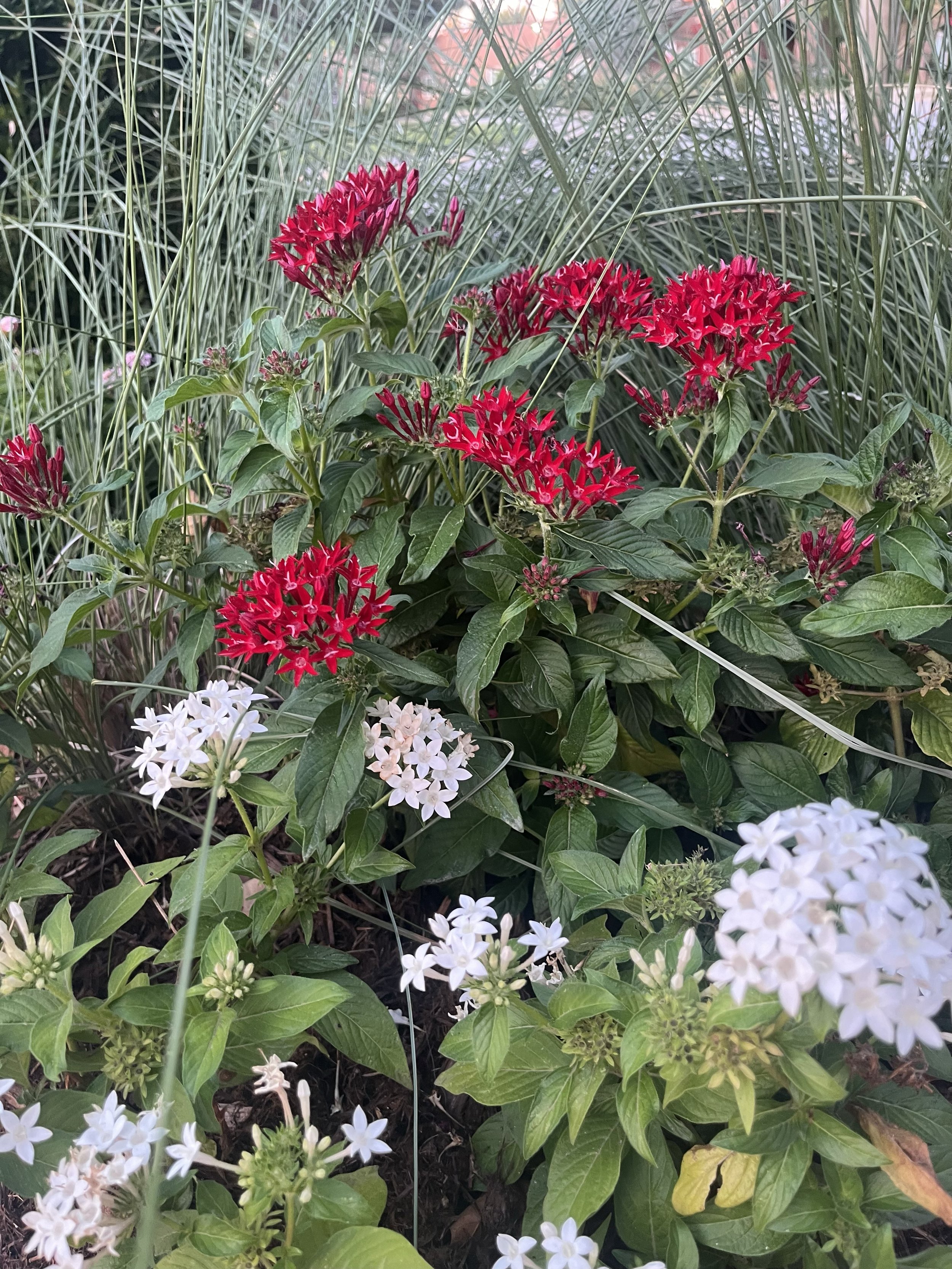
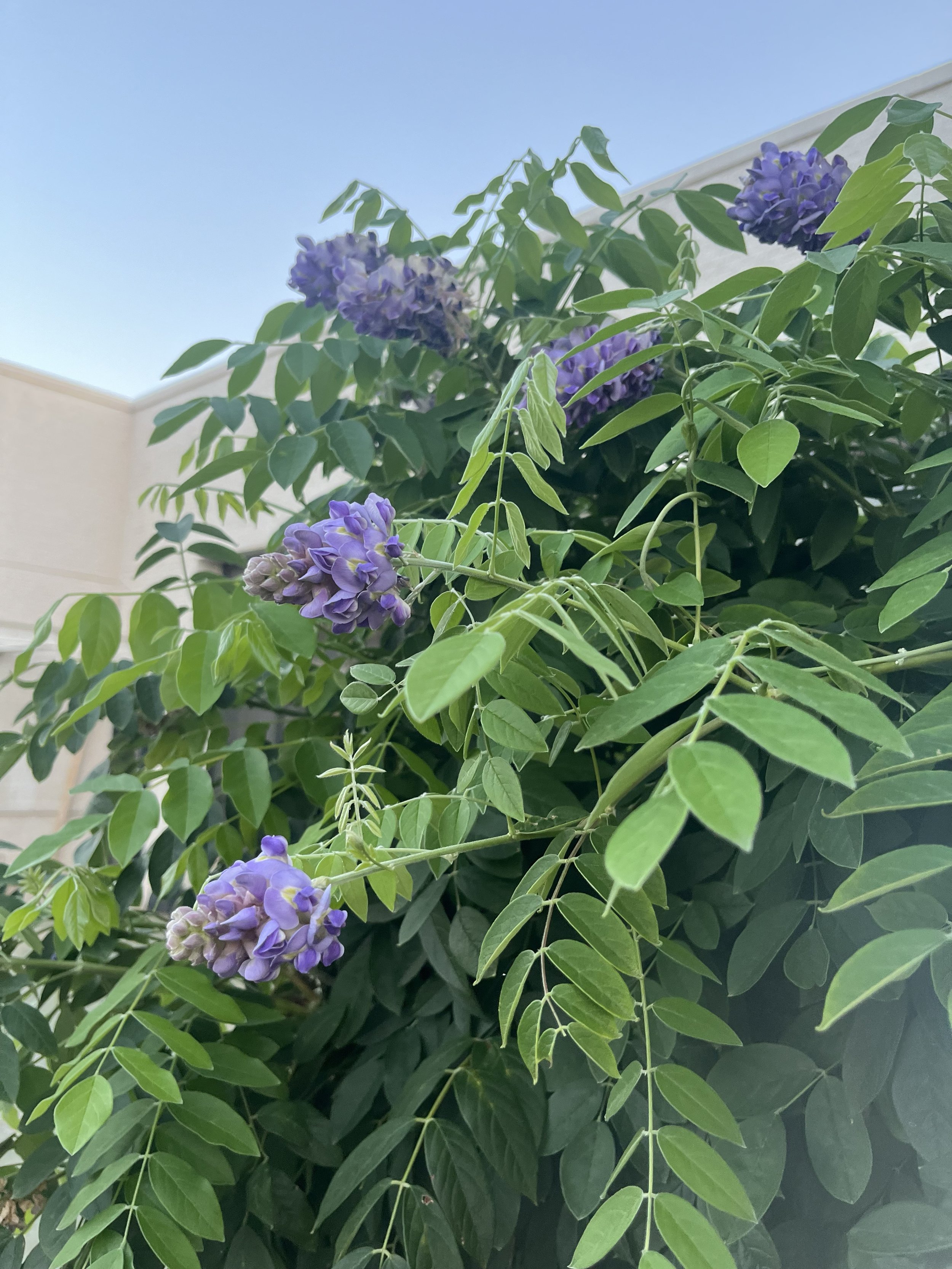
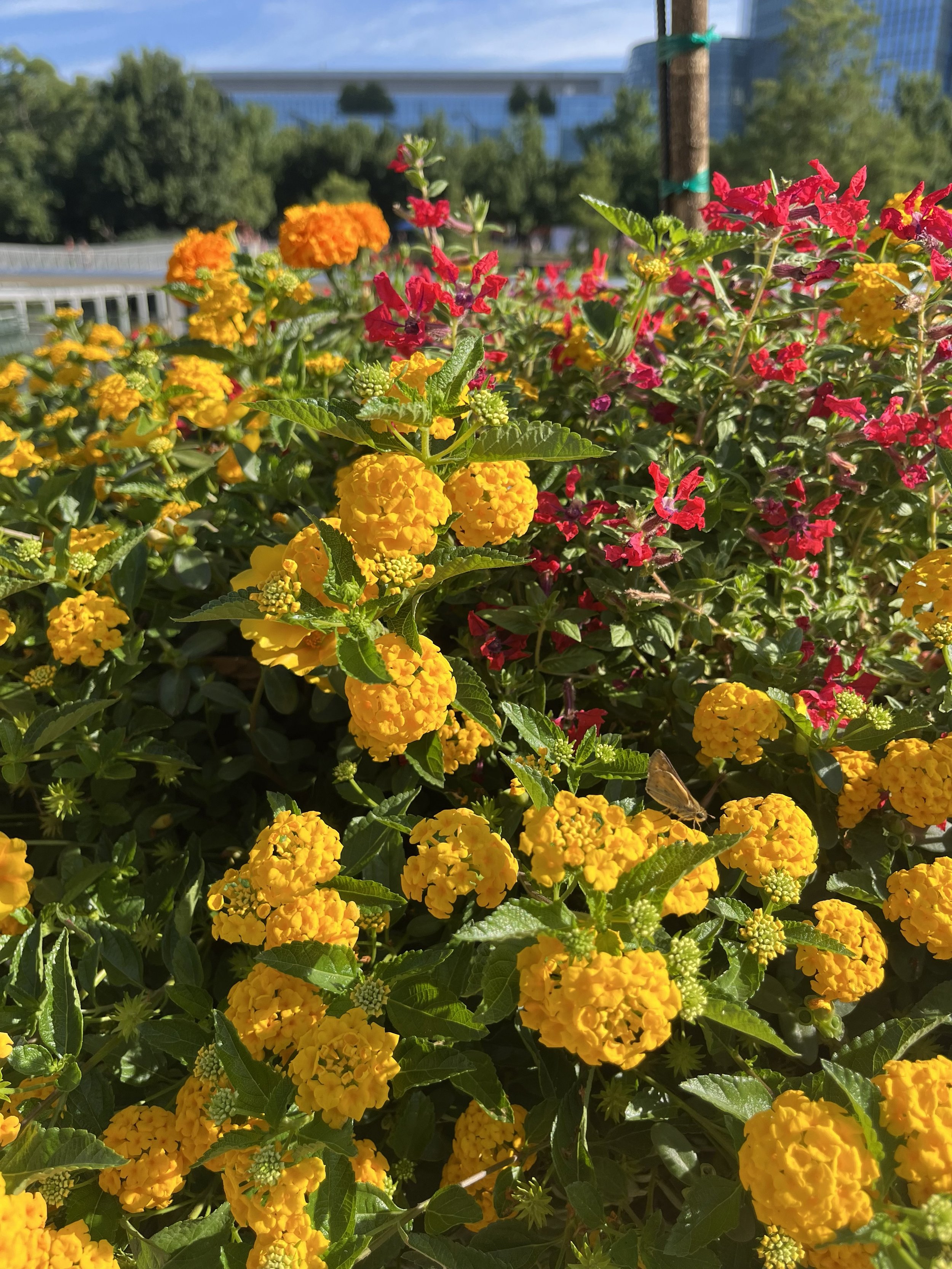
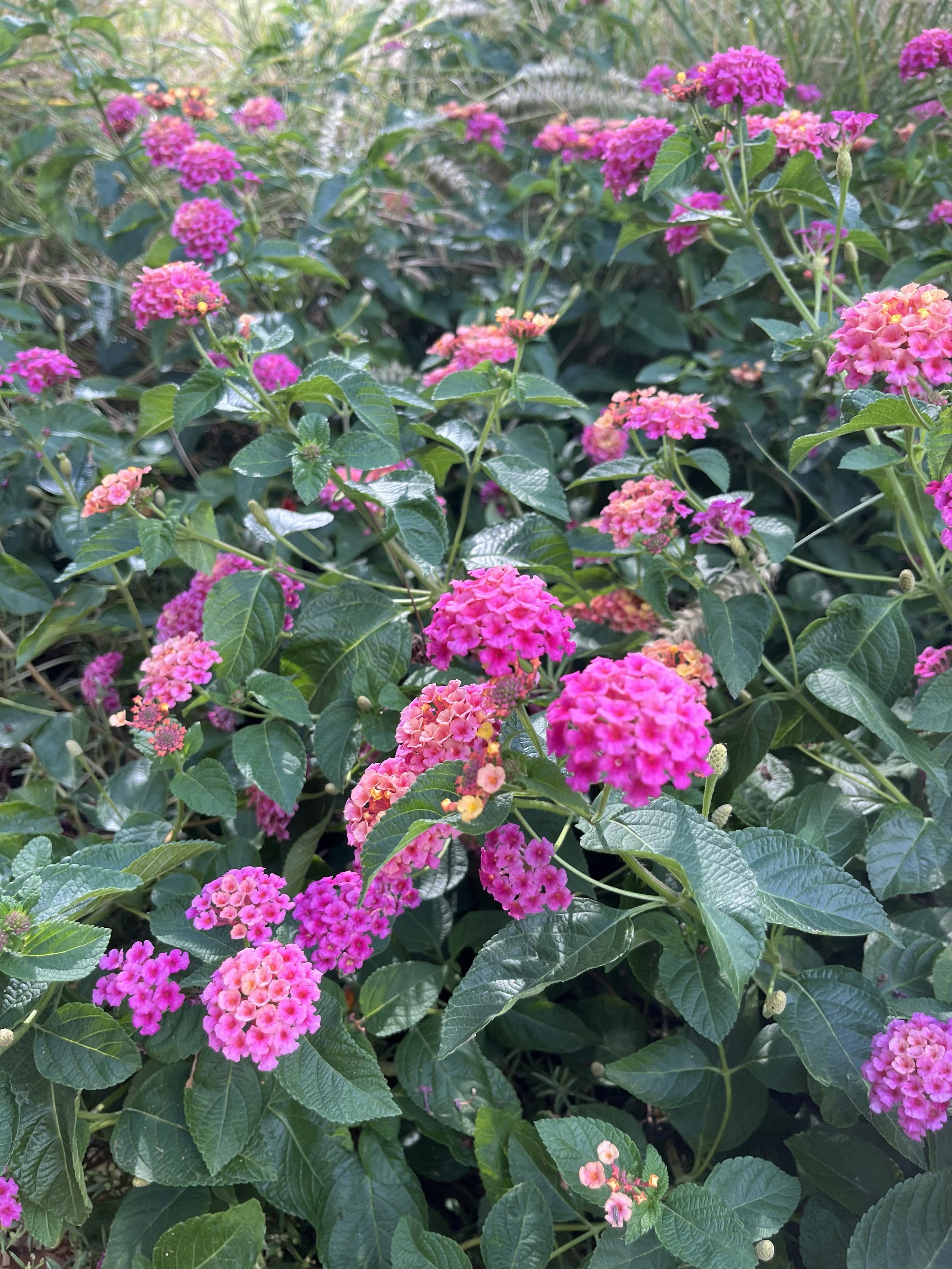
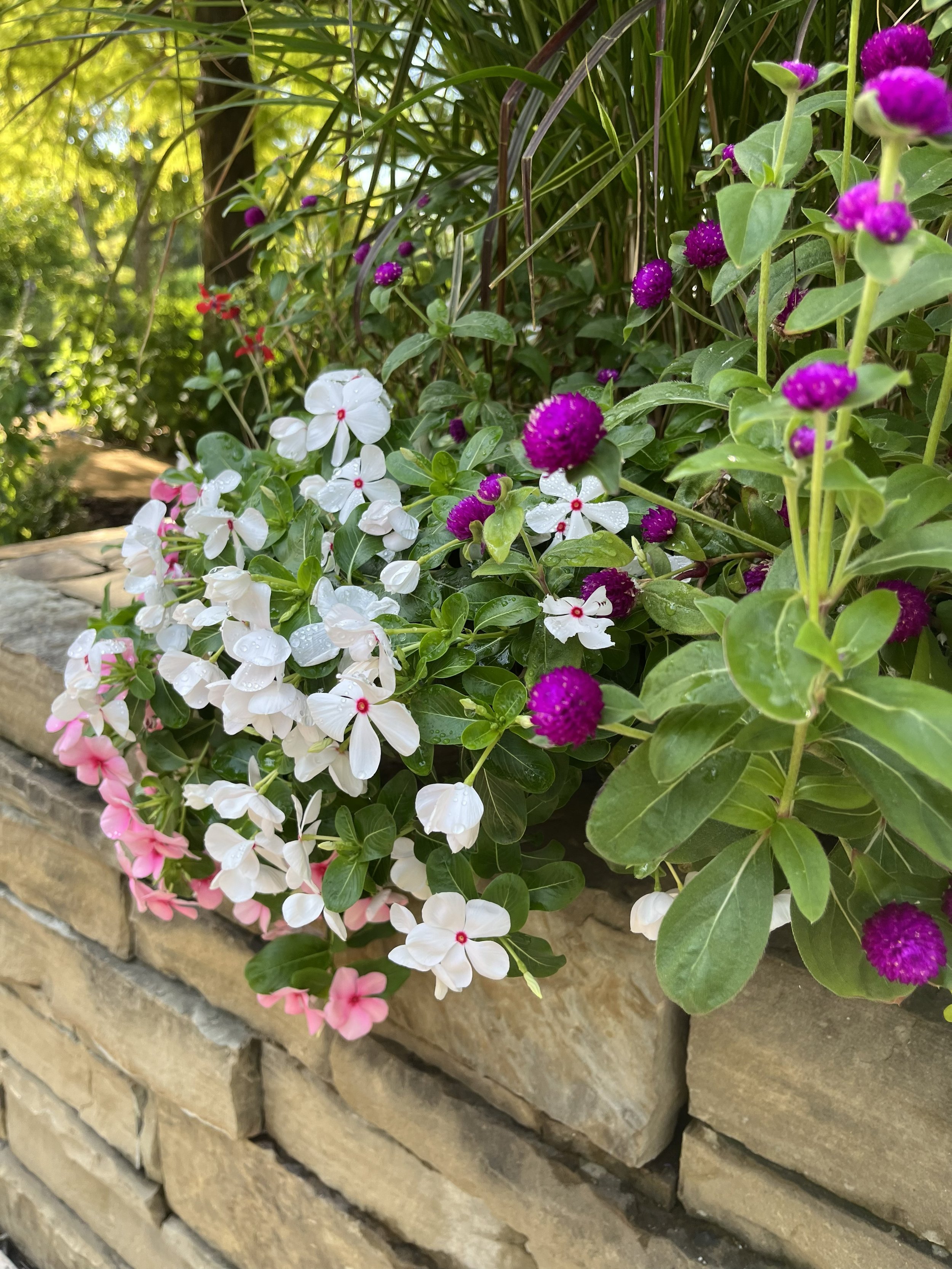
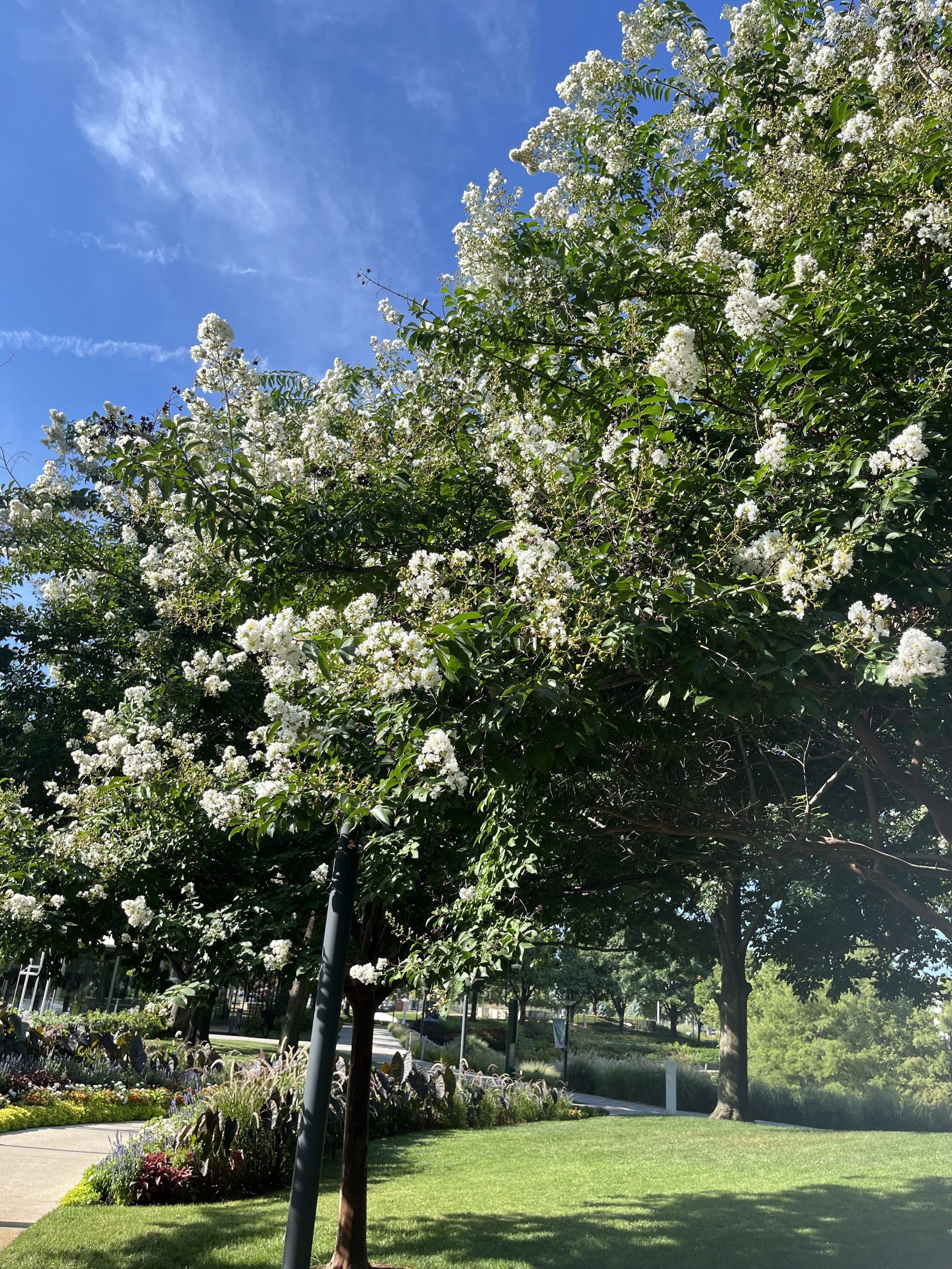
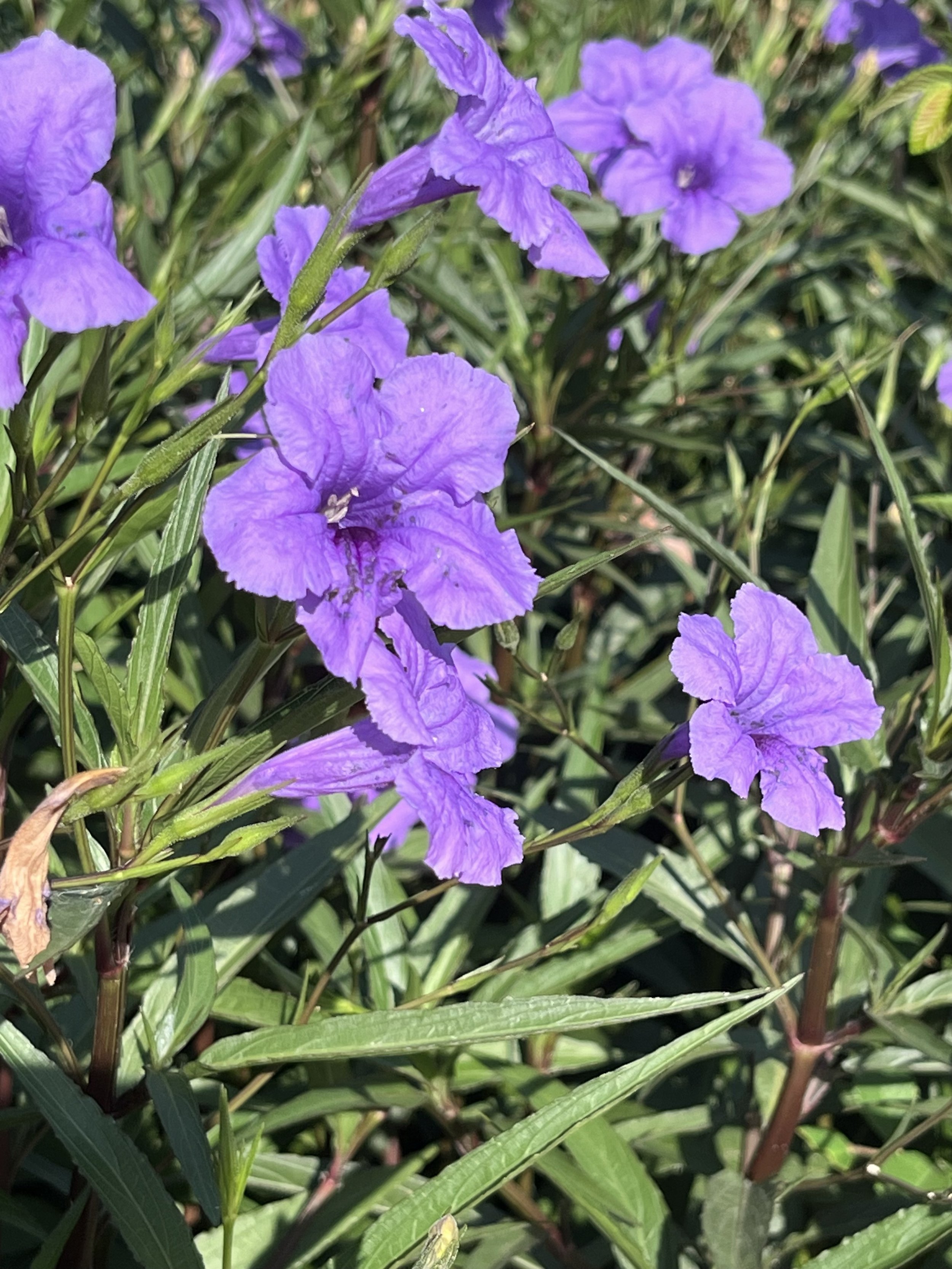
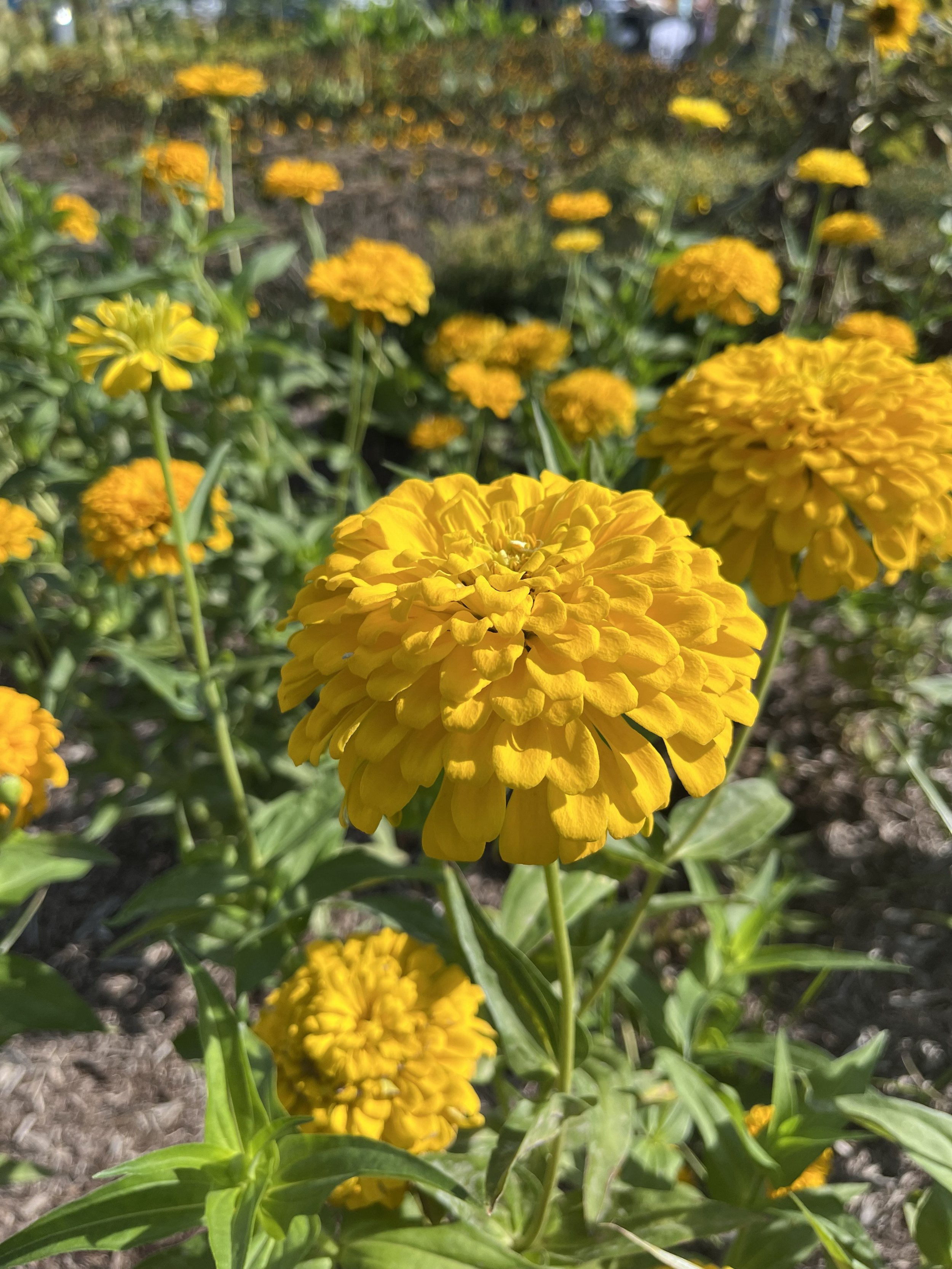

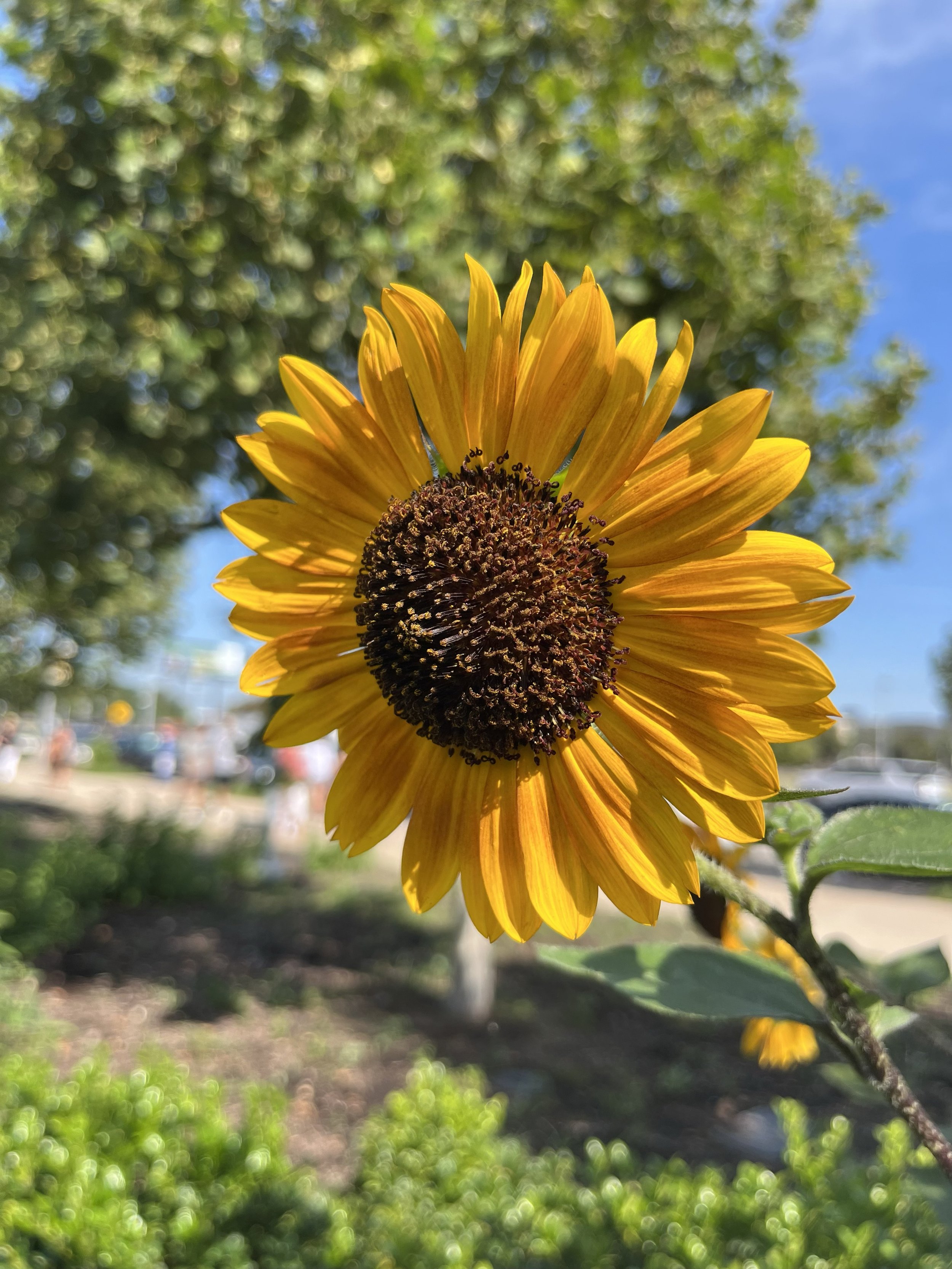
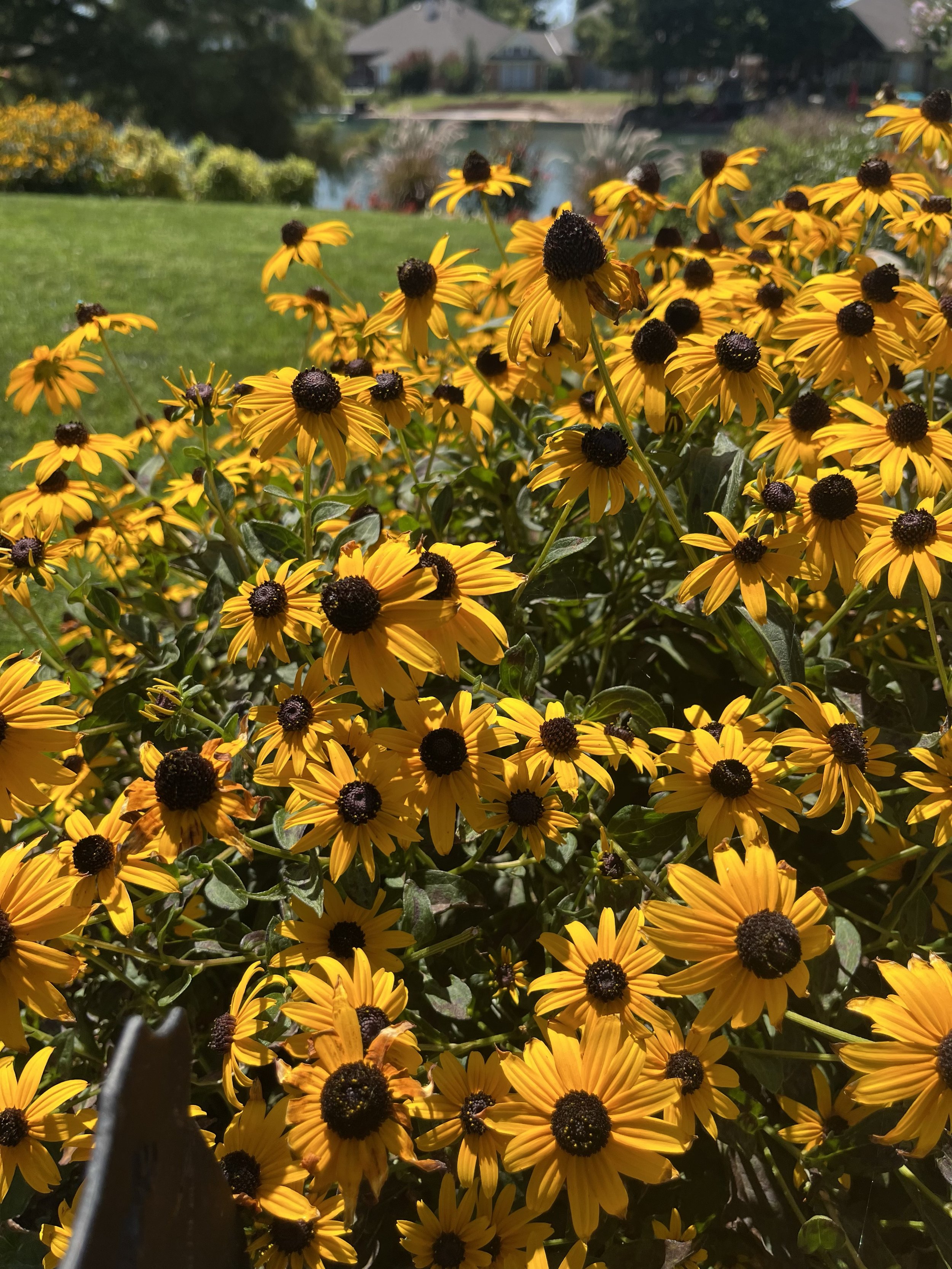
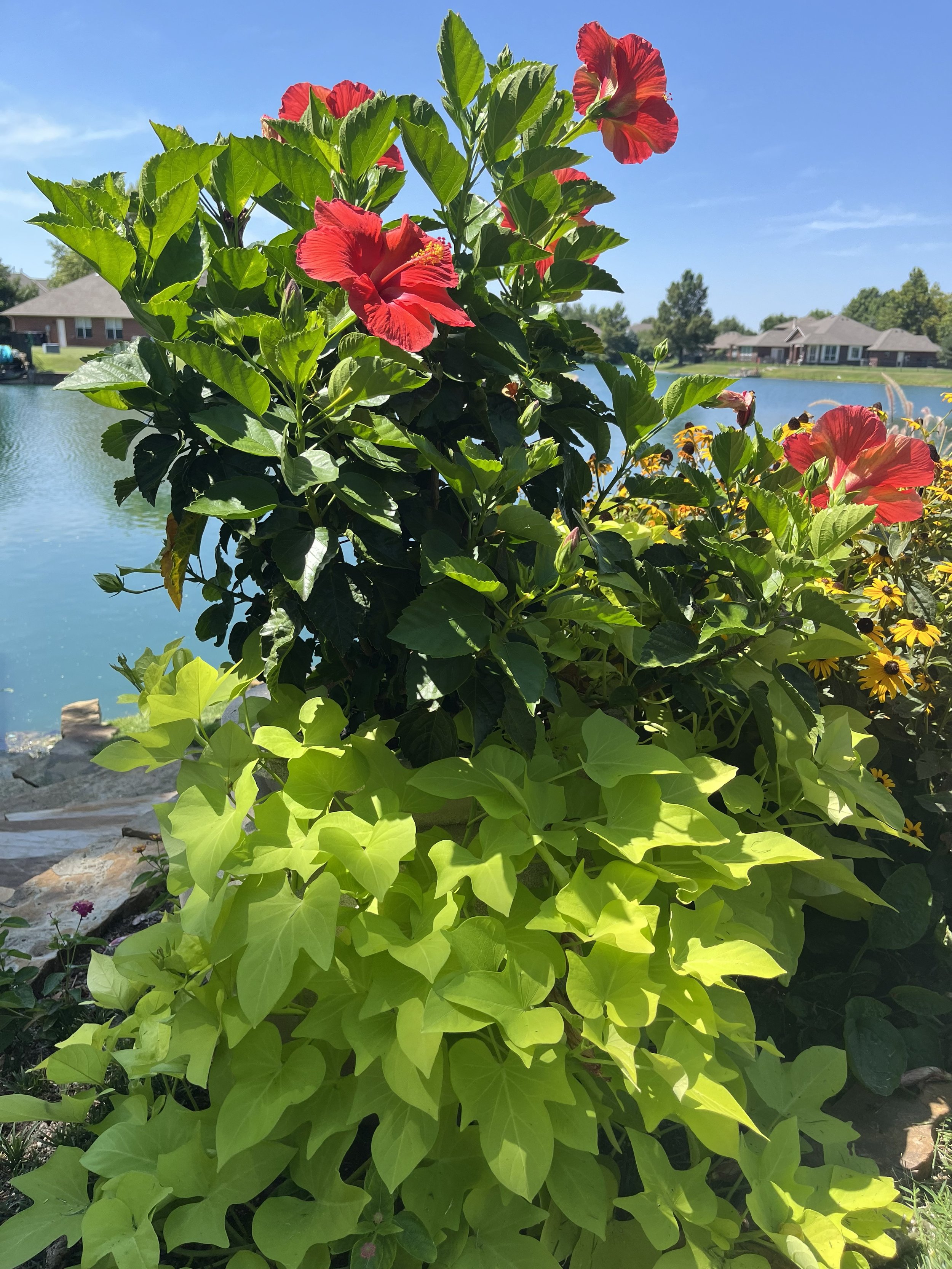
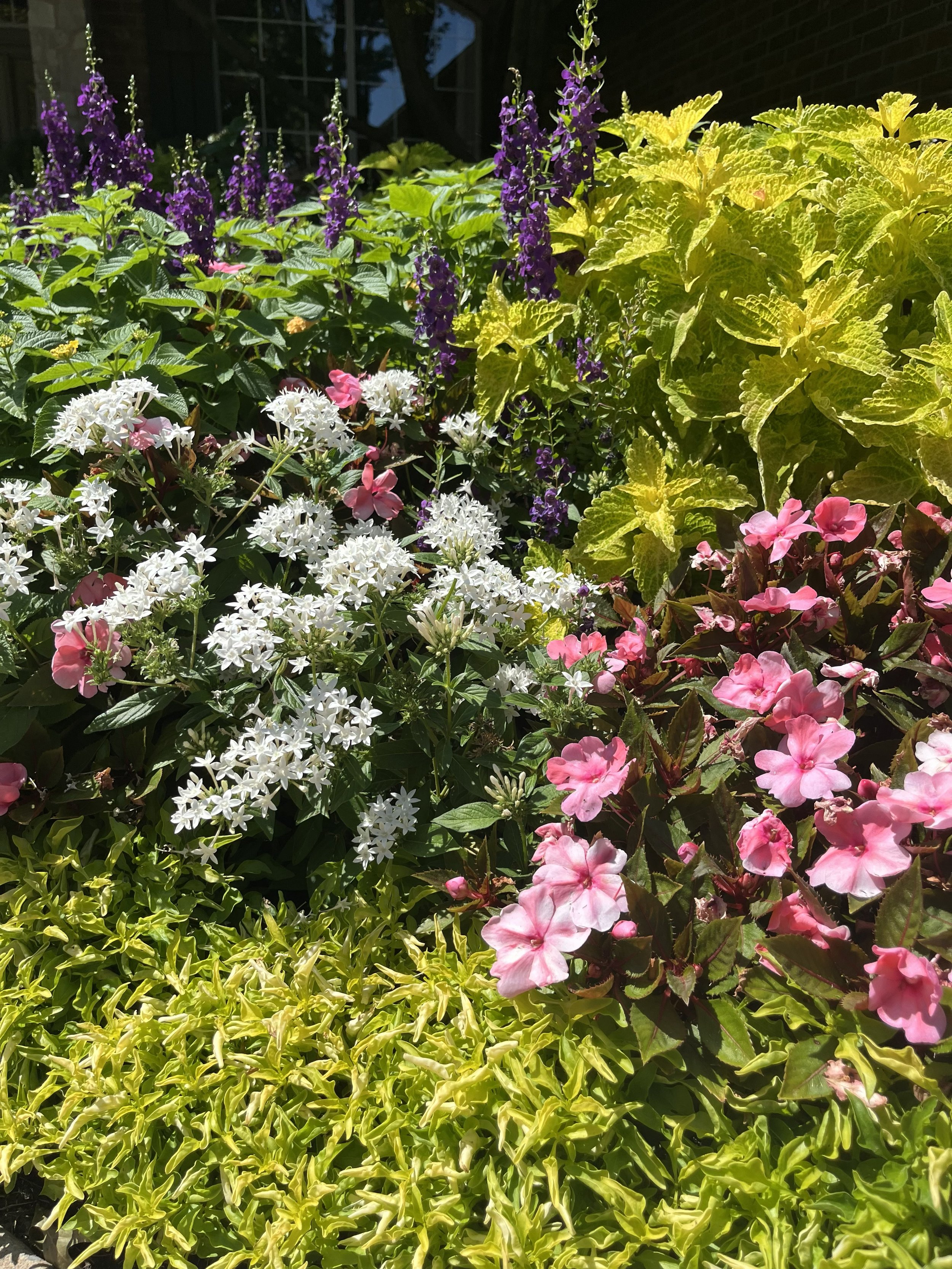
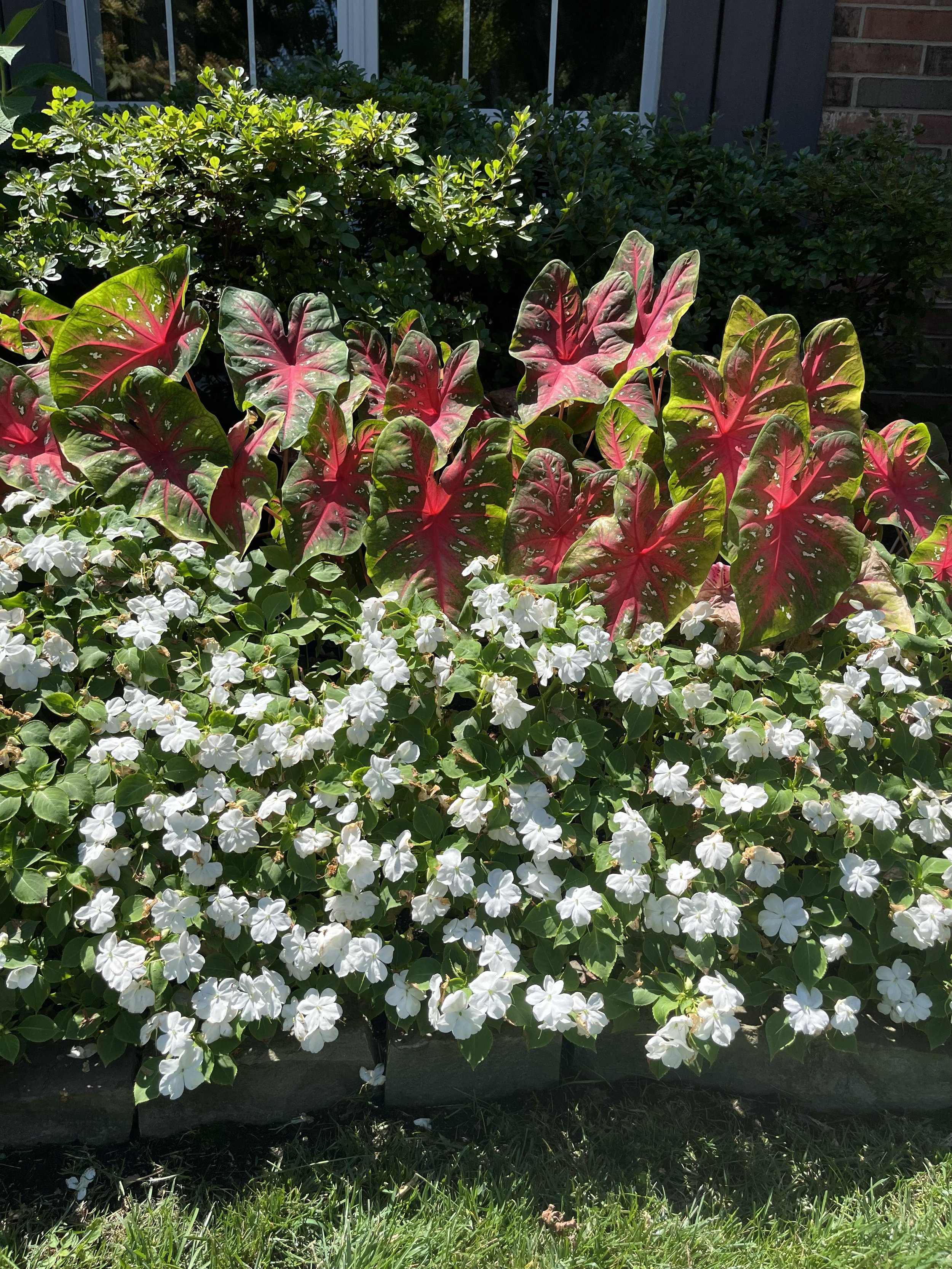
Having a great lawn and landscape through the heat of the summer is a result of good maintenance practices year after year.
A great lawn and landscape are not the result of one season, or even a full year of focus.
A great environment is the result of discovering and developing great practices and then repeating them season after season, year after year.
If you need assistance in developing great practices or have questions concerning your lawn and landscape, give us a call.
Lorne Hall
Hall | Stewart Lawn + Landscape
(405) 367-3873
Summertime = water time!
Friday, June 20th marked the official start of summer. Known as summer solstice, it is the longest day of the year.
So, if it is officially summer, it means it is time to review best watering practices.
Wait a minute, didn’t a local weather person report this week that the past 60 was the 3rd wettest 60-day period in Oklahoma City? That is true. The metro area has received 23” of rain since mid-April. Another way to think of it… in the last 60 days we have received over 60% of our average annual rainfall or 36.5”.
Again, why are we talking about best watering practices?
Because, summer in Oklahoma means temperatures will rise and rainfall will decline.
Best watering practices start with being aware of current weather patterns and adjusting watering schedules.
Best watering practices need to be your number one focus in the landscape for the next few weeks.
Best watering practices will have the biggest impact on the health and appearance of your lawn and landscape for the rest of the summer.
Best Watering Practices:
Apply 1” to 1.5” of water per week.
Your lawn and landscape need 1” to 1.5” of moisture per week when temperatures are consistently 90 degrees or higher.
Which begs the question: “How long should I water?”
Every irrigation system is different – different head types, different size nozzles, different head spacing, different soils, different slopes, etc.
The best way to know how long you should water is to measure the amount of water your system puts out in each zone. Take a few cans and place them around your lawn in a random pattern. Run your sprinklers through a cycle and measure the amount of water in the cans. If the sprinklers ran for 15 minutes and you had .25” of water, that zone needs a total of 60 to 90 minutes of run time per week.
Next determine how long you can run your irrigation before there is excessive runoff. This will tell you how many times per week you need to water. If you can get away with watering every 4th day, you will have a healthier, stronger landscape.
If you don’t have the time to audit the amount of water your system puts out, start with these settings, monitor, and adjust:
Fixed spray pattern heads with 10-15’ spacings – 15 mins per time.
Larger rotor type heads on 20-30’ spacings – 30 mins per time.
My practice has been, using the best practices mentioned here, to water my fescue lawn every 4 days when temperatures are in the 90s and increase to every other day when the lawn shows signs of stress from lack of water.
Set your controller to water with back-to-back run times.
For most of our landscapes, if you run our sprinklers long enough to get the recommended amount of water, you end up with a lot of water running down the street. Splitting zone run time in half and setting the controller to run through the zones back-to-back will improve the amount of water that soaks in and reduce the amount of water that runs off.
Example: Set the controller to run at 4:00 AM and 5:00 AM. When the 4:00 cycle completes, even if it is past 5:00, the controller will start the second cycle.
I know from experience that moist soil will absorb more water than dry soil. Soil is just like the sponge in your sink. A dried-out sponge repels water before it starts absorbing water. Your lawn is the same. The first cycle moistens the soil and the second cycle soaks in.
Split, back-to-back, irrigation cycles are an old golf course trick. Large commercial irrigation controllers have had a run/soak cycle setting that waters a short time, delays, and then waters a longer time for years. Now, more and more smart controllers offer a run/soak cycle feature.
I started using split, back-to-back, irrigation cycles years ago on lawns with slopes.
After seeing great results, I started incorporating the concept on all lawns.
It makes a difference in watering efficiency.
Water in the early morning.
Evaporation is at the lowest point in the pre-dawn hours. Typically, wind is also at the lowest point of the day in the pre-dawn hours.
I prefer to set most irrigation controllers to start at 4:00 AM with the goal of having the cycle completed by 8:00 AM.
Avoid watering in the heat of the day when much of the water will be lost to evaporation. Also, avoid watering in the evening. Watering in the evening promotes many turf diseases because the lawn stays wet too long.
This is critical for fescue lawns. If fescue stays wet for more than 6 hours at a time and nighttime temperatures are in the 70’s, brown patch is unavoidable. Fescue performs best in the heat if it is watered deeply, and grass blades are dry by noon.
If you water your fescue lawn in both the morning and the evening during the summer because you “can’t seem to get enough water on it!”, your lawn isn’t struggling because it is too dry, your lawn is struggling because you have created the perfect conditions for brown patch, a fescue lawn’s worst enemy.
IMPORTANT: Don’t water fescue in the evening during the summer. When water remains in the leaf for more than 6 hours, brown patch disease will develop.
How much difference does infrequent, deep watering make when it comes to developing a drought tolerant lawn? This is a picture of a fescue lawn in full sun in August that is deep soaked every 4 days. The picture was taken in mid-August with less than a 1/4" rainfall in the previous 20 days.
Daily watering is not needed.
Unless you are trying to get newly planted seed to germinate or new sod to take root, there is not a good reason to water every day. Always water deep and infrequent. Daily, shallow watering creates a landscape that is shallow rooted and more dependent on constant moisture for survival.
Fescue will also benefit from deep soakings, every other day, through the summer months. Shallow, daily watering in the summer heat is very damaging to fescue. Again: Brown patch symptoms look very similar to drought stress. Typically, the more you water, the worse the fescue looks, so you add more water, and the cycle of decline continues.
A common myth I would love to dispel is that fescue requires a lot more water than bermuda. Yes, it does for a couple of weeks in the fall when you are trying to get newly seeded fescue to germinate, but mature fescue doesn’t require more moisture than bermuda.
Aeration improves moisture absorption.
You can’t beat aeration for improving your soil structure. A key benefit of improved soil structure is better water absorption. Lawns that receive annual aeration (or at least every other year) do not experience as much runoff.
Head to head coverage is when the water from one sprinkler head reaches all the way to the next head. Without head to head coverage, dry areas can develop around heads.
Fixing uneven water patterns in your lawn may be as simple as making sure heads are straight. A leaning head will result in uneven water distribution.
A clue to an uneven watering problem is an arc pattern matching the sweep of an irrigation head.
Always pay attention to water needs.
If we receive 1/2” of rain or more, turn your controller off for a few days. Install a rain sensor if you are not good at remembering. A rain sensor will pay for itself easily in one season.
Just because it is summer, don’t assume you can leave your controller in automatic and forget it.
Don’t stress if your lawn and landscape gets a little dry, it will rebound quickly once water is applied.
A good indicator that your lawn needs water is the footprint test. If the grass retains your footprints instead of quickly springing back, it is time to resume watering.
Watch for uneven water patterns.
If you notice areas where the lawn color is fading, you may have uneven moisture patterns. This could be the result of a broken head, clogged nozzle, or a head that is out of adjustment.
Even if you don’t have an irrigation system, the concepts of good watering apply.
It is important to learn how long you need to water when you are using a hose end sprinkler. Next time you water, set out a few cans. You will be surprised how long you need to water to get the proper amount of water on your lawn.
Invest in a digital hose water timer, such as the ones made by Orbit. It will make it easier for you to control the timing and frequency of watering.
If you need help in determining your lawn and landscape’s water needs, let us know.
We can schedule an irrigation audit for your lawn and landscape. We will inspect for uneven water distribution, absorb water rates, make recommended irrigation changes, and set the controller for optimal operation. Give us a call if we can help – (405)367-3873.
A healthy landscape is an important part of our environment.
A healthy turf helps clean the air, trap carbon dioxide, reduce erosion, improve groundwater quality, absorb noise, reduce temperatures, as well as adds cub appeal and value to your home.
A key component to a healthy landscape is correct water usage.
Lorne Hall
Hall | Stewart Lawn + Landscape
(405)367-3873
The Epic Summer Battle: Outdoor Fun vs The Mosquitoes. Coming Soon to Your Backyard!
April showers arrived in historic amounts.
Depending on where you live in the Oklahoma City area, you received somewhere between 10” to 15” of rainfall in the last 30 days.
That’s a good thing, right?
Yes, it is great to see the lakes, ponds and streams full. But there are downsides to periods of heavy rain.
One downside… The foundation of a healthy lawn, flower, shrub, and tree are healthy roots. Roots are the primary source of water, nutrients, and oxygen. Yes, oxygen. Plants breath through their root system. Plants can drown when all the air in soil is replaced by water.
Another downside... Nutsedge! Nutsedge thrives in moist, tight soils. It is common to find it growing in areas of poor drainage, around irrigation leaks, and in overwatered lawns. And right now, every lawn in the metro is overwatered.
But the peskiest downside of too much rainfall… Mosquitoes!
Mosquitoes spend three of their four stages of life dependent on moisture and what do we have an abundance of right now… Moisture!
We want your spring, summer and fall to be filled with outdoor enjoyment.
The key to more outdoor time is understanding the life of a mosquito, what you can do to win the battle, and how a mosquito control program can help you win the battle.
Hall | Stewart believes in an integrated pest management (IPM) approach to mosquito control. Success is equally the result of prevention and reduction.
The life of a mosquito –
The mosquito life cycle consists of four stages: egg, larva, pupa, and adult. The first three stages of their life are spent in water. Only adult mosquitoes live outside of water.
Egg Stage: Female mosquitoes lay eggs the surface of still water or a surface that is saturated. Any place where water is standing or is too wet is an invitation for a mosquito to lay eggs.
Larval Stage: The eggs hatch into larvae which live and feed on microorganisms in the water.
Pupa Stage: After the larval stage, the mosquito develops into a pupa . Pupae are comma-shaped and float on the water's surface, breathing through "trumpets."
Adult Stage: The adult mosquito emerges from the pupal case and rests on the water's surface while its wings dry and harden. Once ready, the male and female mosquitoes will then look for food and mates.
Adult females are the only mosquitoes that bite. They typically attack in the evening but occasionally are out during the day. Most afternoons you will find them resting in shrubs, trees and other shady areas.
After a female mosquito has obtained blood meal from a person or animal, they lay their eggs in water or a moist area where their eggs will receive sufficient moisture to hatch.
Typically, an adult mosquito doesn’t fly higher than 10-15’ and don’t venture more than a mile from where life began.
The entire life cycle from egg, to larva, to pupa, to adult, and back to an egg again only takes 4-5 weeks.
What you can do to win the battle –
Mosquito control is everyone’s responsibility when it comes to removing and eliminating larval breeding sites. All standing water is a desirable breeding ground for mosquitoes.
With mosquitoes spending three of their four stages of life dependent on standing water, anywhere water accumulates from bird baths, flowerpots, toys, poor draining gutters, a perfect playground for the insect.
The first step in mosquito control is to remove any standing water – pots, gutters, birdbaths, poor draining lawn areas, etc.
From March through November, any object containing 5–7-day old water is a potential playground for the pest. Even pet bowls can be a breeding ground for mosquitoes. Drain and refill pet bowls and bird baths every 3-5 days at the minimum.
KEY POINT: Routinely remove standing water.
Mosquitoes won’t lay eggs unless there is water.
Their eggs won’t hatch unless there is water.
The egg won’t become a larva unless there is water.
The larva won’t become pupa unless there is water.
Less standing water equals less mosquitoes.
Adult females are the only mosquitoes that bite. They typically attack in the evening, but occasionally are out during the day. Most afternoons you will find them resting in shrubs, trees and other shady areas. After they obtain blood meal from a person or animal they lay their eggs in water or a place where it will get wet. They prefer dark colored containers and shaded areas for egg laying.
What Hall | Stewart can do to help you win the battle –
Barrier treatments are the most effective and proven method for managing pests. A barrier can be made by treating all vegetation, shrubs and trees, from the ground up to a height of 10-15’.
Because adult mosquitoes often rest in the shade of plants, insecticides must be applied to both the top and bottom of plant leaves which is difficult to achieve with a traditional pump-up, handheld spray can.
Power backpack misters are the ideal equipment for barrier treatments as they force droplets into the vegetation and underneath leaves. Other common resting sites, such as under decks, gutters, and other moist shady areas are included in the treatment areas.
Hall | Stewart’s Mosquito Control Program uses two control methods:
An insecticide is used to provide an initial a quick kill and residual control of adult mosquitoes.
A larvicide is used to adversely effect the reproductive cycle of the mosquitoes by preventing larval development resulting in fewer adult mosquitoes.
Due to the short life cycle of mosquitoes, regularly scheduled monthly barrier treatments will provide a significant reduction in the number of insects.
Landscapes with an abundance of cool, shady and moisture areas benefit from the use of mosquito traps and mosquito buckets. If this describes your landscape setting, let’s visit how a more advanced process of mosquito control can help.
The battle is a team effort. You can win by reducing the breeding grounds for mosquitoes and by subscribing to the Hall | Stewart Mosquito Control Program.
We want you to have peace of mind when it comes to outdoor enjoyment this summer.
If you have not already subscribed to our mosquito control program, call (405)367-3873 or respond to this email.
Lorne Hall
Hall | Stewart Lawn + Landscape
(405)367-3873
May Lawn & Landscape Tips
May, the month that your lawn, your landscape, and your life transition from spring to summer.
As much as I love May, I’m not ready to leave April just yet, how about you? But, ready or not, here comes May!
May, another wonderful month to spend outdoors enjoying your lawn and landscape.
May, a month of pleasant evenings and gradually warming days.
May, the month the green of lawns become deeper and the colors of flowers become brighter.
May, the month your attention turns toward summer trips and activities.
But, let’s not jump too quickly to summer. There are several important lawn and landscape tasks to get your lawn and landscape ready for summer.
Turf Fertilizer – Bermuda lawns need a good feeding between late April and the end of May. Bermuda will respond well to a balanced fertilizer with at least 28% to 30% nitrogen and only a small amount of phosphorus and potassium. Fescue turf needs to receive one more fertilizer application between mid-April and mid-May to get them ready for warm days of summer. Once temperatures consistently reach 90 degrees, fertilizing fescue will do more harm than good.
Weed Control - Weeds that were not prevented, both grassy and broadleaf weeds, require additional treatment to control. Now that warm season turf is out of dormancy, control of weeds can be stepped up. During May, it is best to spot spray any persistent perennial weeds, being careful to limit turf damage. Remember, the absolute best weed control is thick and healthy turf.
Nutsedge
Nutsedge will start growing in lawns this month. Because there isn’t a way to prevent nutsedge, spot treatments can be expected. If nutsedge has been a chronic problem in your lawn, annual aeration will make a difference. Nutsedge thrives in tight, wet soils and since aeration reduces compaction, we find yards that are aerated annually have less nutsedge issues.
Maynight Salvia, the perfect name for the perennial that adds bright blues and purples to the May landscape.
Anytime we make an application of weed control or fertilizer, please let us know if you have any concerns 10-14 days after our visit. If the turf isn’t greening up properly, or if weeds are not wilting, we want to know. If you are new to our program, we know it will take time to get your lawn to the healthy condition you desire. But, we expect to make progress with each visit. We know this may require additional visits and if you are on our full 7- Step Program, we will make the needed extra visits.
Oakleaf Hydrangeas will start gracing the landscape with their white blooms this month.
Tree & Shrub Care – We subscribe to an integrated pest management approach. When it comes to insects and disease, you always have to be on the lookout. Take a few minutes each week to inspect your landscape for insects and disease.
Spider Mites – During the summer months when it is hot and dry, we are on the watch for spider mites, the Two-spotted Spider Mite. But, there is also the Spruce Spider Mite that is active in the spring and fall. They can be found on spruce, pines, junipers and arborvitae. It can cause considerable damage early in the season before we are even thinking about spider mites. The first indication of the Spruce Spider Mite damage is off-green color needles. Spider mites are not controlled by normal insecticides. If you try to control them yourself, you must use a product labeled as a miticide. Insecticides will not control spider mites.
The first indication of Spruce Spider Mite damage is an off-green color on your spruce, pine, juniper or arborvitae.
Bagworms - May is the month to be watching for bagworms on needle evergreens. Bagworms are quite easy to control when they are small. But, they are very hard to see when they first start to develop. If you notice bagworms, or have a concern about your plants, please let us know.
Bagworms
Spider mites are small and almost impossible to see on the plant. If you are concerned you have spider mites, shake the plant over a white sheet of paper. If the little specks start moving they are spider mites.
Be on the lookout for bagworms this month. They are much easier to control when they are small.
Leaf spot
Leaf Spot - Leaf spots will develop if we have periods of sufficient moisture and temperatures are just right for development of the fungus. The best host for leaf spot is an already unhealthy plant in an area with poor air circulation. Control includes spraying with a fungicide at least two times in a 10–14-day period, keeping fallen leaves picked up and disposed of, and thinning the tree or shrub to improve air flow.
Aphids – A small insect that isn’t easy to spot, but the honeydew, sticky substance they excrete is easy to spot. Aphids develop on the underside of leaves, often reaching large populations before you notice them. Early detection is important, and if caught early, a high-pressure blast of water may do the trick. As the weather warms, populations increase, and insecticide treatment will be needed.
Lawn Maintenance – Both warm and cool season turf grasses need frequent mowing now. One of the most important things for good turf health is to avoid removing more than 1/3 of the grass in one mowing. Not only does it not yield you the best-looking lawn when you cut below the leaf and into the stem of the grass, it also weakens the root system. Try to maintain your bermuda on the middle setting or just below the middle setting in May. For fescue, raise the setting one notch this month and cut the lawn 2.5-3” tall. By early June, it is best to have fescue at a maximum height going into the summer.
When mowing frequently, only remove 1/3 of the grass, don’t bag the clippings. Mulch them back onto the lawn. Grass leaf blades are mostly nitrogen and water and are very beneficial to the lawn.
Dianthus is a perennial that graces the May landscape with vibrant blooms and gray and green foliage.
May Night Salvia, Dianthus and Gold Moneywort make a colorful combination in the May landscape.
Full sun planting of lantana, penta, angelonia, and sunpatiens.
Sun Coleus
Fescue color is at its best this month.
Lantana and Sun Coleus make a great summer combination in full sun, hot areas. May is the month to plant them.
Seasonal Color – May is the month to plant your summer annual color. Most landscapes look best with a splash of bright color creating a welcoming environment near the front door. Impatiens and Caladiums are great choices for full shade areas. Begonias, petunias, and geraniums do well in sun to part shade. For full sun, periwinkle, lantana, sunpatiens, angelonia, sun coleus and penta are good at handling the heat.
Penta
Caladium
Clematis vines produce an abundance of showy flowers starting this month and continuing into the summer.
Take into consideration the mature size when planting seasonal color. The temptation is to over plant.
Irrigation – The last two weeks of April delivered on the promise of “April showers.” Hopefully, you are taking advantage of the rainfall and turning your irrigation off. Assuming normal temperatures in the 80’s, your lawn and landscape requires 1” of water per week in May. The best irrigation management is one that includes keeping an eye on rainfall, soil moisture, and temperatures. Monitor conditions, turn your system off if when are in a rainy period. Poor water management is setting the irrigation system at the beginning of the season and letting it run regardless of the conditions.
If you have subscribed to our Irrigation Management program with the Rainbird Wi-Fi Link, we will make watering decisions based on soil temperatures, soil moisture, temperatures, and recent rainfall and adjust your controller via the Rainbird app.
Moisture Retention – Tired of high water bills during the summer months? Hall | Stewart has a new program just for you, Moisture Retention. The program includes two applications (April-May & July-August) of a unique root zone moisture management product that reduces the overall watering requirements of your lawn and landscape resulting in less frequent watering. For more details, give us a call or spend a few minutes visiting our post from April 5th.
Peonies have started to add stunning blooms to the landscape.
Peonies not only add great color to your late spring landscape, they also make excellent cut flowers.
Endless Summer Hydrangeas will produce their first blooms this month.
Oakleaf Hydrangeas are adding flower buds now that will grace the landscape later this month with large white blooms.
The same plantings in July
Wisteria
Periwinkle
Remove the brown stems on your hydrangeas left from the winter back to the first bud this mont.
Azalea Care – Azaleas were stunning again this spring. Azaleas require a little more care, but they are worth it. Fertilize azaleas this month. After blooms fade and before the end of June prune azaleas if needed. Pruning after mid-summer will result in less blooms next year. Azaleas look best when minimally pruned and allowed to retain their natural shape. Prune by removing longer shoots by reaching down and making cuts where they come off a larger branch. This will improve air moment and promote healthy growth. Avoid shearing azaleas. Add a fresh layer of mulch to keep the soil cooler and retain moisture during the warm summer months to come. The best mulch for azaleas is pecan hulls or pine bark.
Oakleaf Hydrangeas add graceful white blooms to the landscape in May.
Hydrangea Pruning – If you haven’t already, now is the time to prune the brown stems left from the winter back to the first bud. In most cases this is the only pruning recommended for hydrangeas. During the summer, if you want to you can snip off spent blooms, but it is not required. Otherwise, keep the pruners and shears away from your hydrangeas. And…never prune in the fall. Need more information on hydrangea care, visit our recent post on hydrangeas.
Gold Mound Spirea not only add interest to the landscape with their foliage, they also deliver an additional touch of color with red-violet blooms this month.
If you have any questions, please drop us an email or give us a call at (405)367-3873.
Our mission is to help you have your best lawn and landscape…one that improves the appearance, enjoyment and value of your surroundings.
Lorne Hall
Hall | Stewart Lawn + Landscape
(405)367-3873
Aeration… the "Then Some” of Lawn Care
A good lawn is the result of several key activities:
1. Correctly timed pre-emergent applications to prevent weeds before they germinate.
2. Applying the right amount of fertilizer to ensure you have a thick and healthy turf.
3. Regularly scheduled mowing that only removes the top 1/3 of the leaf blade each time.
4. Infrequent, deep watering based on seasonal need.
But, there is a 5th activity that too often is overlooked.
George Toma, the greatest groundskeeper in the history of sports, has a saying:
“Do the job and then some. It is the ‘then some’ that
distinguishes the mediocre from the great.”
George Toma played a part in preparing the playing field for every Super Bowl until he retired after Super Bowl LVII at the age of 95. Toma is known as “The Sodfather!”
George Toma, presenting the keynote address at a turf conference several years ago, started his talk by announcing he was going to discuss the three most important things to have a great turf.
His 1st point was Aeration.
His 2nd point was Aeration.
And, you guessed it, his 3rd point was Aeration.
What are the benefits of aeration?
Soil compaction is reduced.
Air movement into the soil is improved.
Fertilizer can quickly reach the root zone.
Water runoff and puddling is reduced.
Roots grow stronger and deeper.
Thatch is reduced.
Reduction in weeds that thrive in compacted soils.
For George Toma, the “then some” that distinguishes the mediocre lawn from a great lawn is aeration.
Aerification is a must!
If your goal is to have your best lawn possible, aeration is a required step in your lawn care program.
What is aeration?
Aeration is the process of mechanically removing 2”-3” cores of soil, 4”-6” apart, from your lawn.
Compact soils prevent grass from establishing a healthy root system and prevent air, water, and nutrients from reaching the root zone. Walking, playing, and mowing (in other words everything you do on your lawn) increases soil compaction.
As Oklahomans, we know about tight clay, compacted soils. Our clay soils make growing a great lawn a challenge.
Too often we accept soil compaction as just the way it is and settle for the status quo of an average lawn.
Stop accepting the norm!
You don’t have to struggle with the results of growing a lawn in tight, compacted soil.
Golf courses typically aerate their turf at least two times per season. No wonder the fairways look so much better than most home lawns.
Lawns with compacted soil also are more susceptible to weed development. Most weeds thrive in tight compacted soil.
Nutsedge, one of the most difficult to control summer weeds, thrives in tight soils. Our experience has shown that annually aerated lawns have far less problems with nutsedge.
Why do golf course fairways always look so good? Turf managers know the importance of aeration. The secret to a great lawn is a great root system. Annual aeration is the ticket to a great root system.
Should the cores be removed or left on the lawn?
Leave the cores on the lawn. As they breakdown and dissolve, they will refill the holes with loose soil resulting in improved soil structure. The cores will break up and settle back into the lawn within a few weeks.
When should you aerate?
Warm season lawns (Bermuda and zoysia) should be aerated any time after spring green-up and before the end of July.
Cool season lawns (fescue) should be aerated in the fall, September through October. Aeration in conjunction with overseeding will not only improve the soil structure, but it will also improve seed soil contact resulting in better seed germination.
Now through the first half of the summer growing season is the best time to aerated lawn Bermuda, a warm season turf.
Nothing will take your lawn from good to great more than an annual aeration!
One more Toma saying… “The most important part of grass is the soil and the root system.”
Aeration is the best way to improve the soil structure and develop a stronger root system.
Aeration, the most overlooked lawn practice, will give you a healthier, more vigorous, less weedy lawn.
To achieve your best lawn, annual aeration is a must.
Lorne Hall
Hall | Stewart Lawn + Landscape
(405)367-3873
Where Are the April Showers?
It is rare to be addressing watering practices in April. Who thinks about watering issues in April?
Regardless of the time of year, one of the best practices for your lawn and landscape is to pay attention to rainfall and supplement with good watering practices when needed.
Good watering practices start with being aware of current weather patterns and making adjustments to watering schedules.
Good watering practices are one of the biggest influences in the health and appearance of your landscape.
The west and north areas of the Oklahoma City metro are way behind on spring moisture. Lawns and landscapes that are not receiving supplemental moisture are showing signs of drought stress. Unfortunately, most people are not used to paying attention to their lawn & landscape’s moisture needs in April.
Best Watering Practices:
Your lawn and landscape need 1” of water per week during the spring.
A common question is “How long should I water?” Every irrigation system is different – different head types, different size nozzles, different head spacing, different areas, etc.
The best way to know how long you should water is to measure the amount of water your system puts out in each zone. Take a few cans and place them around your lawn in a random pattern. Run your sprinklers through a cycle and measure the amount of water in the cans. If the sprinklers ran for 15 minutes and you had .25” of water, you need 60 minutes per week.
Next, determine how long you can run your irrigation before there is excessive runoff. This will tell you how many times per week you need to water.
If you can get away with watering every 4th-day versus every other day, you will have a healthier, stronger lawn and landscape.
If you don’t have the time to audit the amount of water your system puts out, start with these settings, monitor, and adjust:
Fixed spray pattern heads with 10-15’ spacings – 15 mins per time.
Larger rotor type heads on 20-30’ spacings – 30 mins per time.
Set your controller to water with back-to-back run times.
For most of our landscapes, if we run our sprinklers long enough to get the recommended amount of water, we end up with a lot of water running down the street. Splitting zone run time in half and setting the controller to run through the zones back to back will improve the amount of water that soaks in and reduce the amount of water that runs off.
Example: Set the controller to run at 4:00 AM and 5:00 AM. When the 4:00 cycle completes, even if it is after 5:00, the controller will start the second cycle.
Moist soil will absorb more water than dry soil. Soil is just like the sponge in your sink. A dried sponge repels water before it starts absorbing water. Your landscape is the same. The first cycle moistens the soil and the second cycle soaks in.
Split, back-to-back, irrigation cycles are an old golf course trick.
I started using split, back-to-back, irrigation cycles a few years ago on lawns with slopes.
After seeing great results, I started incorporating the concept on all lawns.
It makes a difference in watering efficiency.
Water in the early morning.
Evaporation is at its lowest point in the pre-dawn hours. Also, the wind is usually at the lowest point of the day in the pre-dawn hours. I prefer to set most irrigation controllers to start at 4:00 AM with the goal of having the cycle completed by 8:00 AM.
Avoid watering in the heat of the day when much of the water will be lost to evaporation. Also, avoid watering in the evening. Watering in the evening promotes many turf diseases because the lawn stays wet too long.
IMPORTANT: Don’t water fescue in the evening during the summer. When water remains in the leaf for more than 6 hours, brown patch disease will develop.
Daily watering is not needed.
Unless you are trying to get newly planted seed to germinate or new sod to take root, there is not a good reason to water every day. Always water deep and infrequent. Daily, shallow watering creates a landscape that is shallow-rooted and more dependent on constant moisture for survival.
Fescue will benefit from a deep soaking just like Bermuda. A common myth I would love to dispel is that fescue requires a lot more water than Bermuda. Yes, it is when you are trying to get newly seeded fescue to germinate, but mature fescue doesn’t require more moisture than Bermuda.
I water my fescue the same way I water Bermuda – deep, infrequent cycles.
It’s April! Fescue should be at their best. If you have areas of fescue that are not rich green, check the soil moisture. If you can slip a large screwdriver several inches into the soil, you need to water.
Aeration improves moisture absorption.
You can’t beat aeration for improving your soil structure. A key benefit of improved soil structure is better water absorption. Lawns that receive annual aeration (or at least every other year) do not experience as much runoff.
Always pay attention to water need.
If we receive .5” of rain or more, turn your controller off for a few days. Install a rain sensor if you are not good at remembering. A rain sensor will pay for itself easily in one season. Don’t assume you can leave your controller in automatic and forget it.
Don’t stress if your lawn and landscape gets a little dry, it will rebound quickly once water is applied.
A good indicator that your lawn is needing water is the footprint test. If the grass retains your footprints instead of quickly springing back, it is time to resume watering.
Fescue growing on the top of a sprinkler head.
Watch for uneven water patterns.
If you notice areas where the lawn color is fading, you may have uneven moisture patterns. This could be the result of a broken head, a clogged nozzle, or a head that is out of adjustment.
Head to head coverage is when the water from one sprinkler head reaches all the way to the next head. Without head to head coverage, dry areas can develop around heads.
A clue to an uneven watering problem is an arc pattern matching the sweep of an irrigation head.
Even if you don’t have an irrigation system, the concepts of good watering still apply.
It is important to learn how long you need to water when you are using a hose-end sprinkler. Next time you water, set out a few cans. You will be surprised how long you need to water to get the proper amount of water on your lawn. Invest in a digital hose water timer, such as ones made by Orbit. It will make it easier for you to control the timing and frequency of watering.
A healthy landscape is an important part of our environment. A healthy turf helps clean the air, trap carbon dioxide, reduce erosion, improve groundwater quality, absorb noise, reduce temperatures, as well as, adds curb appeal and value to your home.
Let’s hope metro-wide spring moisture arrives soon.
Our environment needs it. Our lawns and landscapes need it.
But, if it doesn’t, be prepared to put the best watering practices in place.
Lorne Hall
Hall | Stewart Lawn + Landscape
(405)367-3873


















